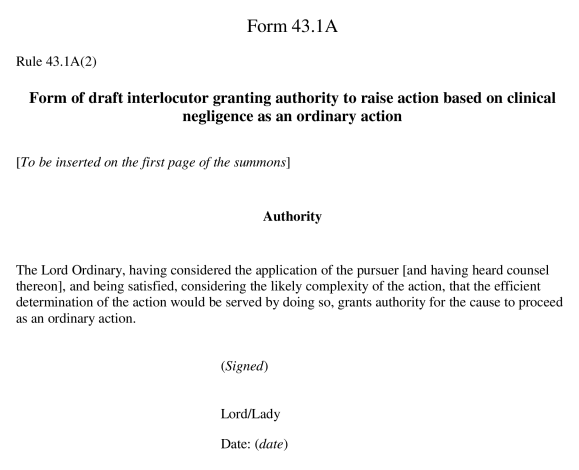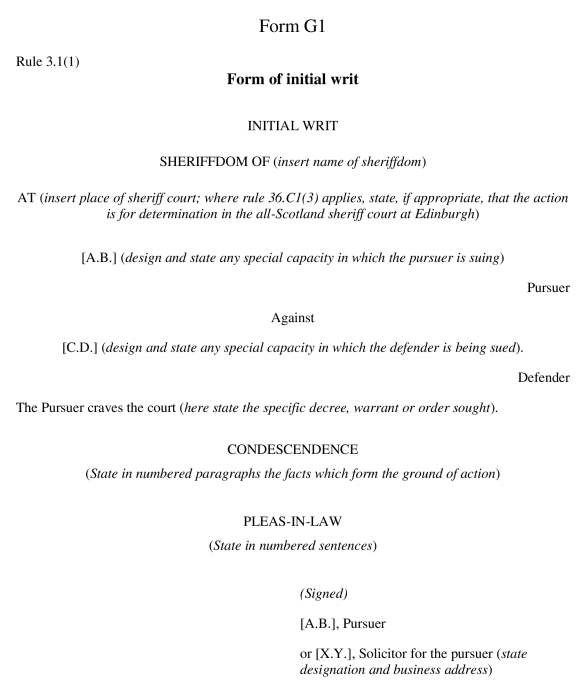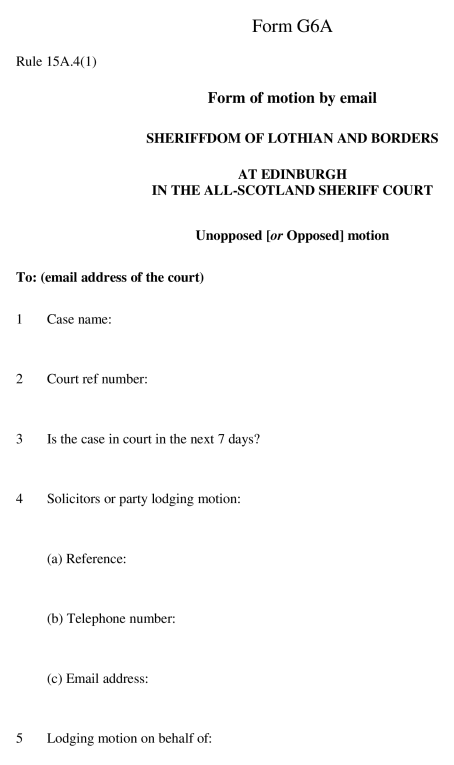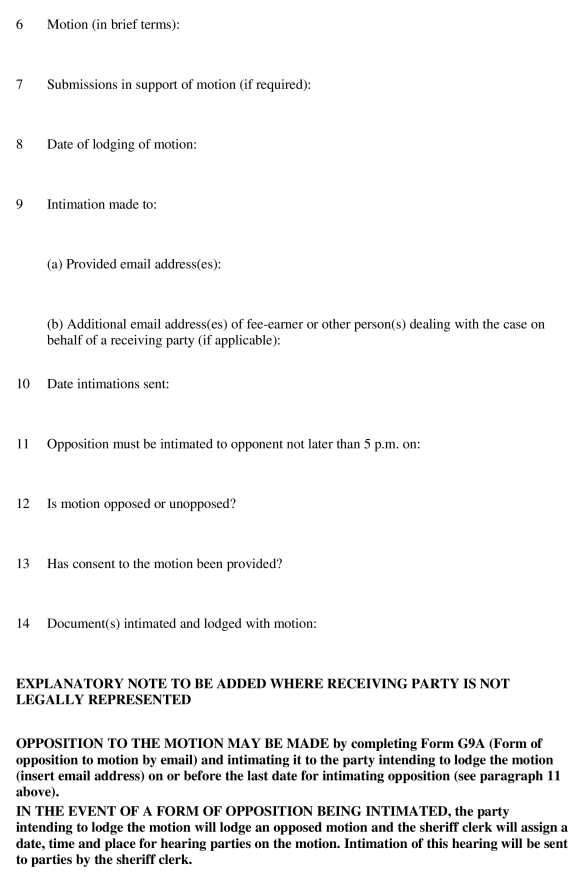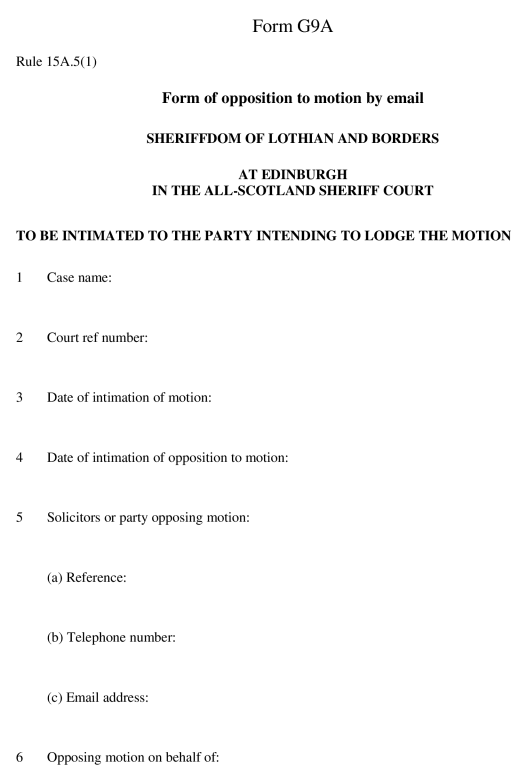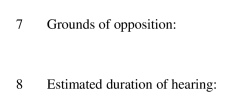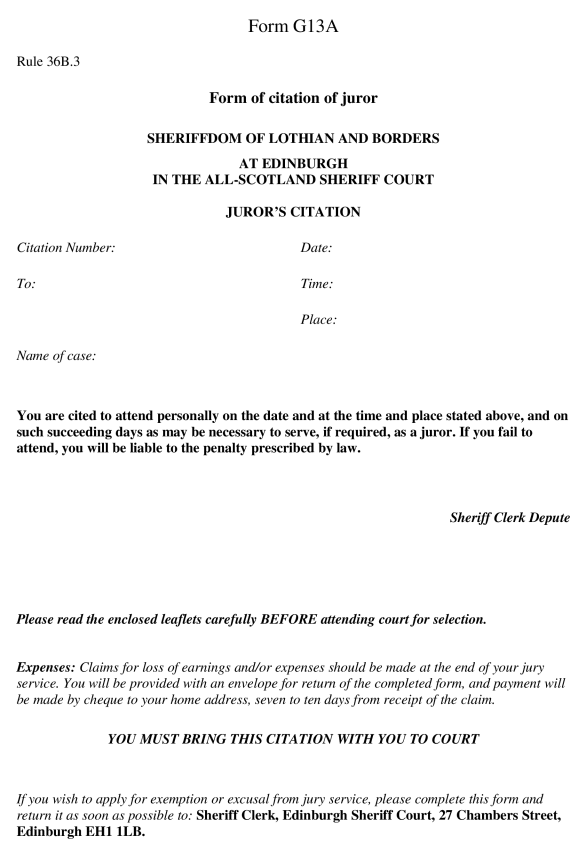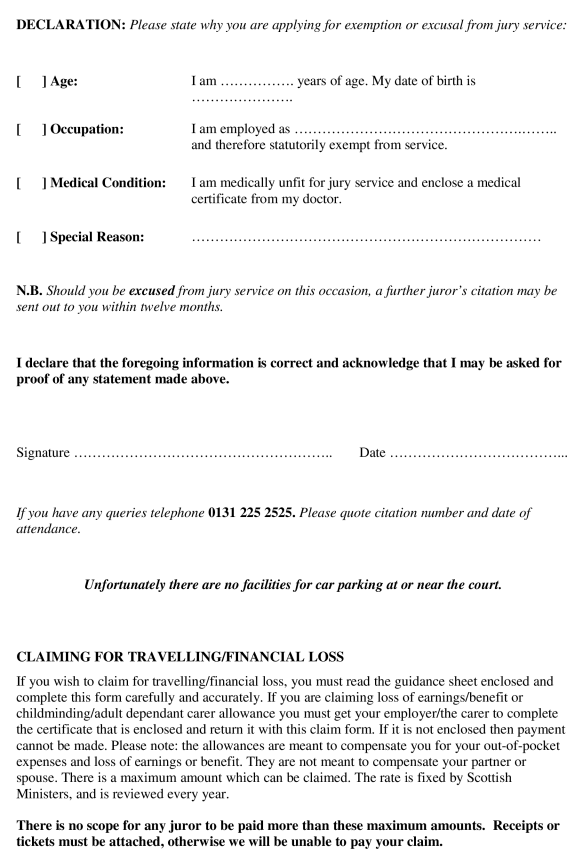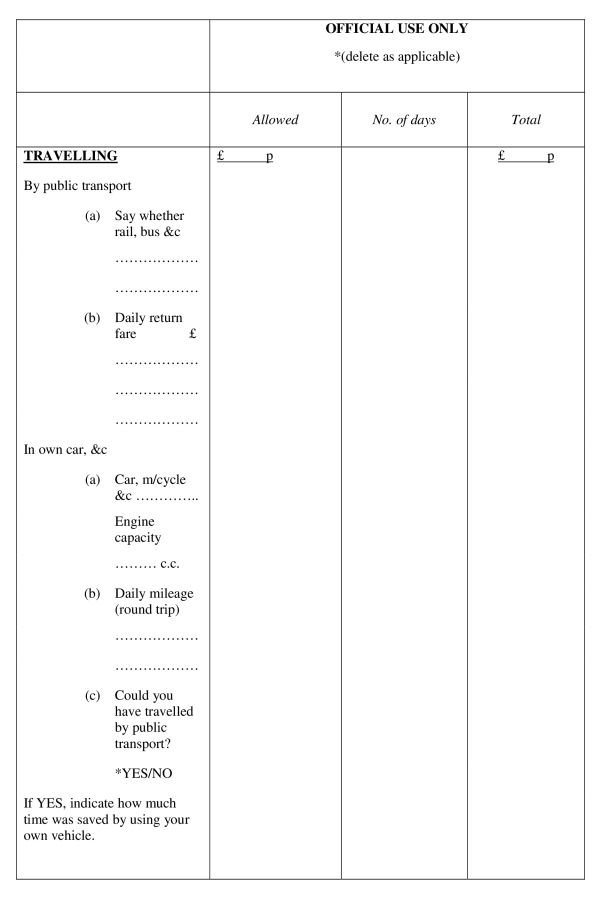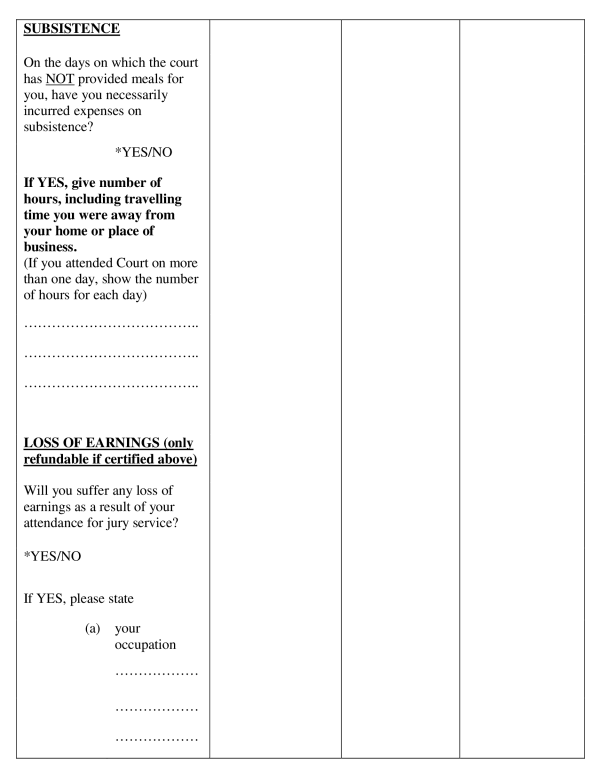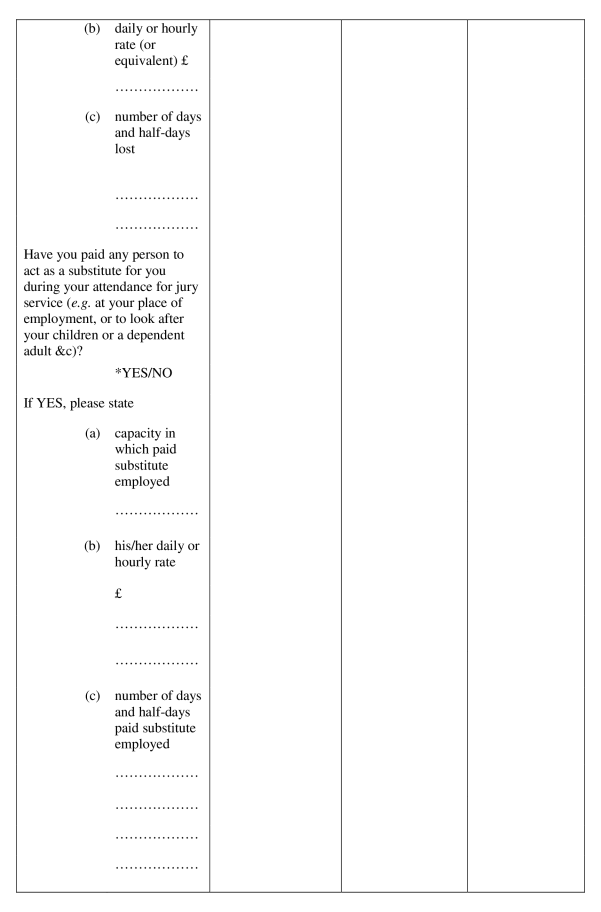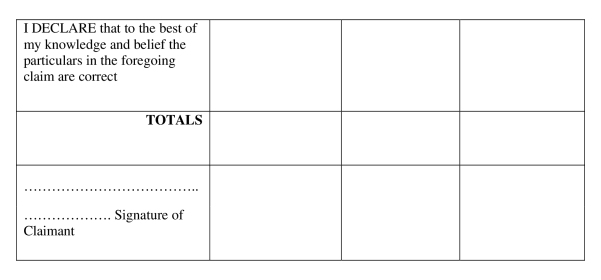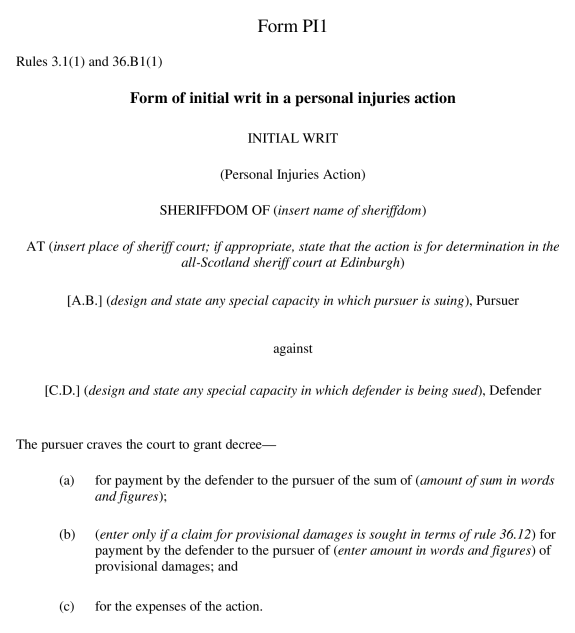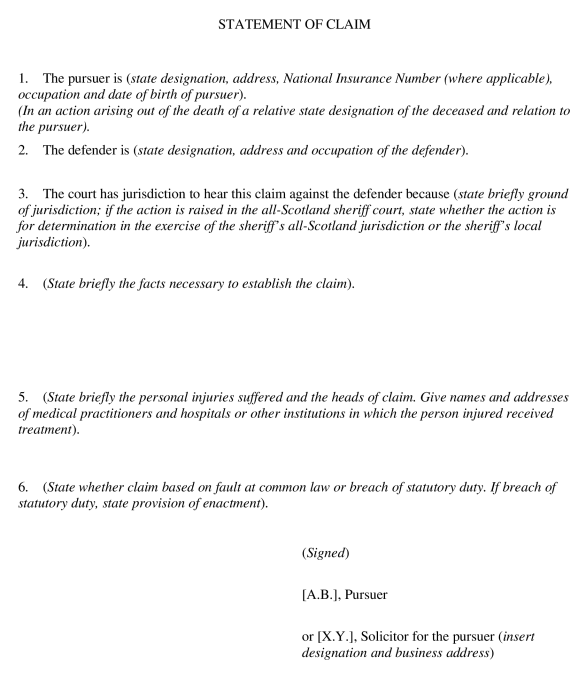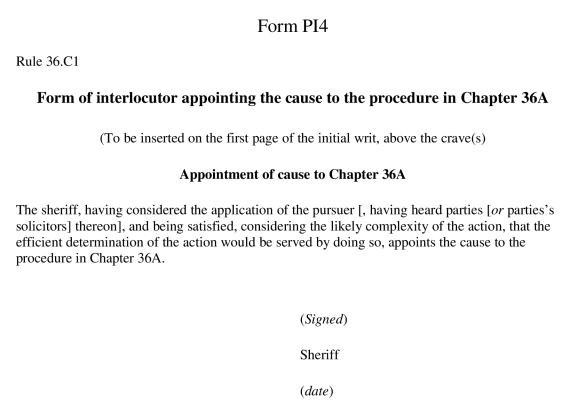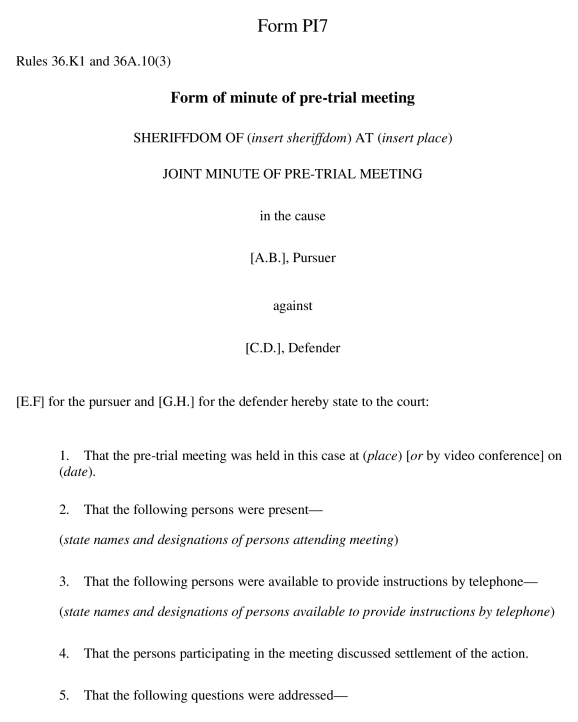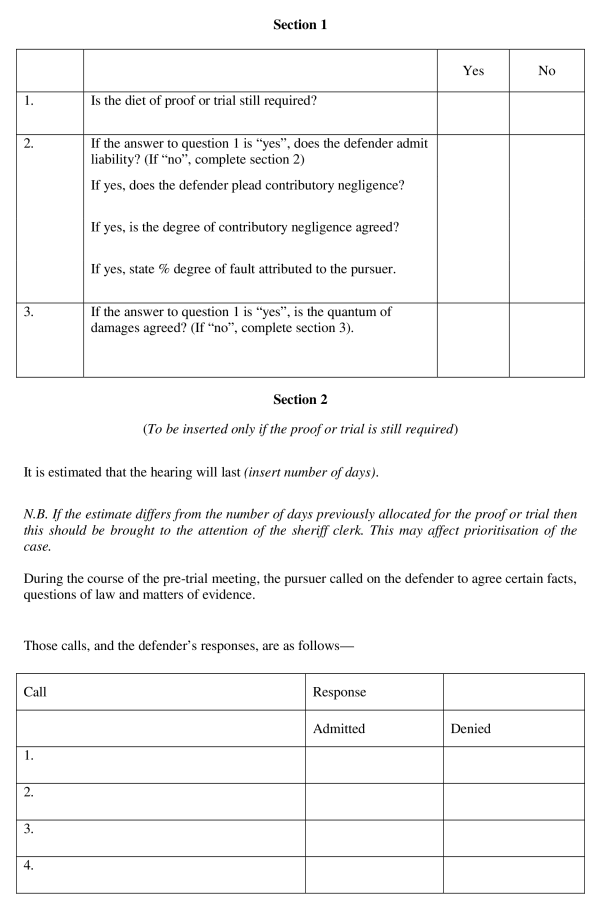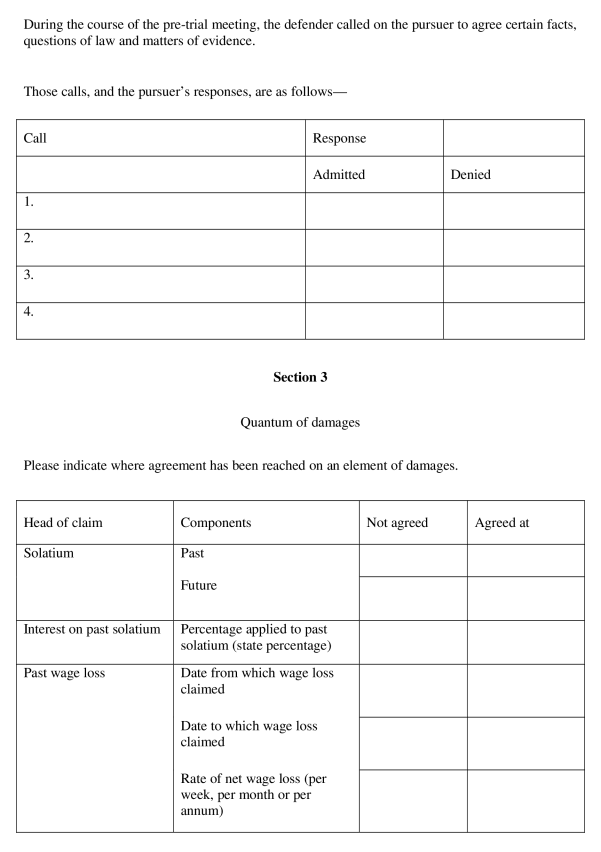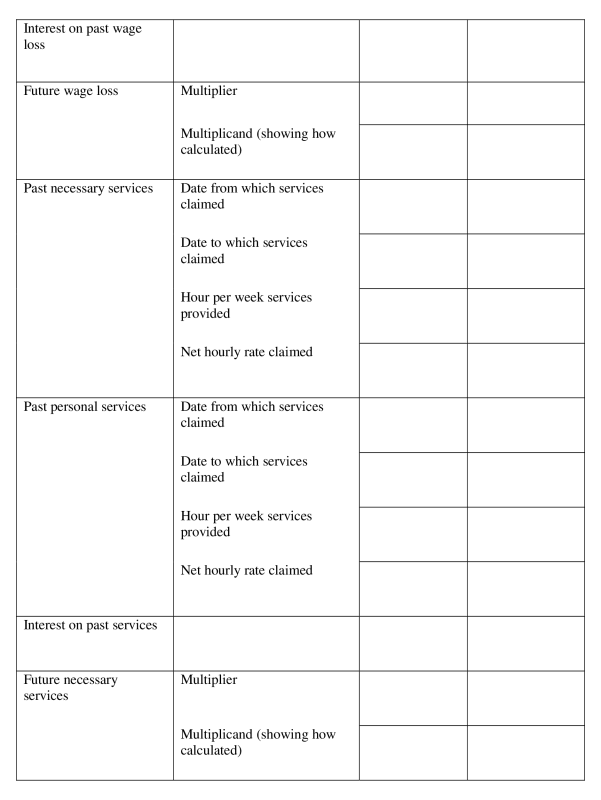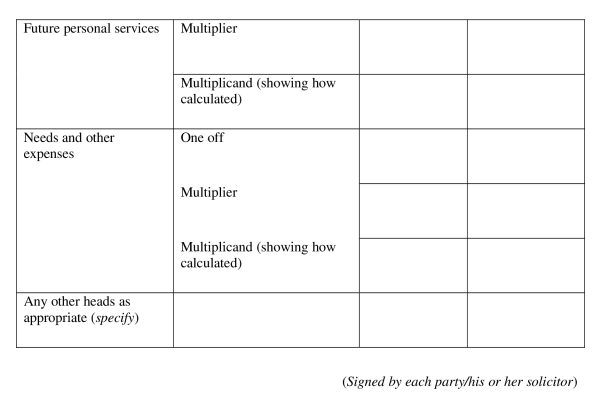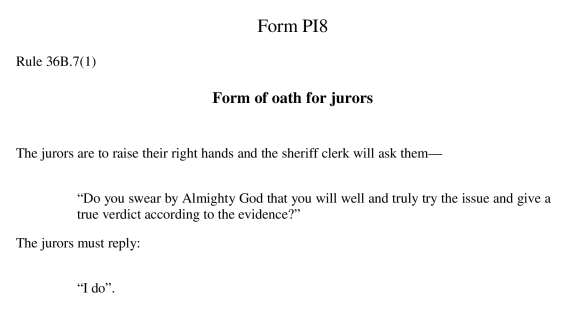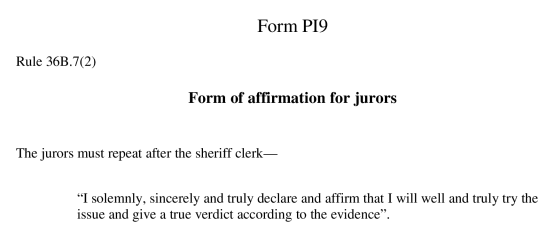- Y Diweddaraf sydd Ar Gael (Diwygiedig)
- Gwreiddiol (a wnaed Fel)
Act of Sederunt (Rules of the Court of Session 1994 and Sheriff Court Rules Amendment) (No. 2) (Personal Injury and Remits) 2015
You are here:
- Offerynnau Statudol yr Alban
- 2015 No. 227
- Whole Instrument
- Blaenorol
- Nesaf
Rhagor o Adnoddau
Status:
Dyma’r fersiwn wreiddiol (fel y’i gwnaed yn wreiddiol). This item of legislation is currently only available in its original format.
Scottish Statutory Instruments
2015 No. 227
Court Of Session
Sheriff Court
Act of Sederunt (Rules of the Court of Session 1994 and Sheriff Court Rules Amendment) (No. 2) (Personal Injury and Remits) 2015
Made
2nd June 2015
Laid before the Scottish Parliament
4th June 2015
Coming into force
22nd September 2015
In accordance with section 4 of the Scottish Civil Justice Council and Criminal Legal Assistance Act 2013(1), the Court of Session has approved draft rules submitted to it by the Scottish Civil Justice Council with such modifications as it thinks appropriate.
The Court of Session therefore makes this Act of Sederunt under the powers conferred by sections 103(1) and 104(1) of the Courts Reform (Scotland) Act 2014(2) and all other powers enabling it to do so.
Citation and commencement, etc.
1.—(1) This Act of Sederunt may be cited as the Act of Sederunt (Rules of the Court of Session 1994 and Sheriff Court Rules Amendment) (No. 2) (Personal Injury and Remits) 2015.
(2) It comes into force on 22nd September 2015.
(3) A certified copy is to be inserted in the Books of Sederunt.
Amendment of the Rules of the Court of Session 1994: miscellaneous
2.—(1) The Rules of the Court of Session 1994(3) are amended in accordance with this paragraph.
(2) In rule 1.3(1) (interpretation etc.)(4), after the definition of “the Act of 1988”, insert—
““the Act of 2014” means the Courts Reform (Scotland) Act 2014.”.
(3) In rule 37.2(5) (citation of jurors)(5), omit “by the first class recorded delivery service”.
Amendment of the Rules of the Court of Session 1994: remits
3.—(1) The Rules of the Court of Session 1994 are amended in accordance with this paragraph.
(2) In rule 32.1 (remits to sheriff court)—
(a)in paragraph (1), for “section 14 of the Law Reform (Miscellaneous Provisions) (Scotland) Act 1985 (remit from court to sheriff)” substitute “section 93 of the Act of 2014 (remit of cases from the Court of Session)”;
(b)in paragraph (2), omit “under section 14 of the Law Reform (Miscellaneous Provisions) (Scotland) Act 1985”.
(3) After rule 32.2 (transmissions on contingency), insert—
“Form of remit request
32.2A.—(1) A request under section 92(4) of the Act of 2014 (request for remit to the Court of Session) is made by interlocutor.
(2) Within 14 days of the issuing of that interlocutor, the party seeking the remit must lodge—
(a)a remit request, consisting of—
(i)the whole pleadings and interlocutors in the cause;
(ii)the note of the sheriff mentioned in rule 26.2A(2) of the Ordinary Cause Rules 1993 in Schedule 1 to the Sheriff Courts (Scotland) Act 1907;
(b)a process in accordance with rule 4.4 (steps of process).
Determination of remit request
32.2B.—(1) Where a remit request is lodged, the court is to put the request out on the By Order roll in order that the party seeking the remit and any other party to the sheriff court proceedings may make submissions about whether the proceedings should be remitted.
(2) The Lord Ordinary, having heard parties, may—
(a)refuse the request; or
(b)make an order under section 92(5) of the Act of 2014 allowing the proceedings to be remitted.
(3) The Deputy Principal Clerk must, within 4 days after the interlocutor has been pronounced under paragraph (2), send a copy of the interlocutor to the sheriff clerk of the sheriff court specified in the interlocutor.”.
(4) For rules 32.4 (lodging of process and motion for further procedure), 32.5 (reponing against failure to comply with rule 32.4(1) or (2)) and 32.6 (insistence in remit by another party) substitute—
“Lodging of process and motion for further procedure
32.4.—(1) Within 14 days after the date of receipt of the sheriff court process, the party who sought the remit must make up and lodge in the General Department a process incorporating the sheriff court process.
(2) Where that party has already lodged a process under rule 32.2A(b), the party must incorporate the sheriff court process in that process within the same period.
(3) When the party who sought the remit has complied with paragraph (1) or (2)—
(a)that party must apply by motion for an order for such further procedure as that party thinks fit,
(b)the cause is to proceed as if it had been an action in the court initiated by a summons.
(4) A motion under paragraph (3)(a) is to be disposed of by the Lord Ordinary.
Reponing against failure to comply with rule 32.4
32.5.—(1) Where the party who sought the remit fails to comply with the requirements of rule 32.4(1), (2), or (3)(a) (lodging of process and motion for further procedure), that party may apply by motion to be reponed within 7 days after the expiry of the period specified in rule 32.4(1).
(2) Paragraph (3) applies where the failure mentioned in paragraph (1) is a failure to lodge a process under rule 32.4(1), or incorporate a process in accordance with rule 32.4(2).
(3) The party enrolling a motion under paragraph (1) must, on enrolling that motion—
(a)lodge a process in accordance with rule 32.4(1), or, as the case may be, incorporate a process under rule 32.4(2);
(b)apply by motion for an order for such further procedure as that party thinks fit.
(4) A motion under paragraph (1) is to be granted only on cause shown and on such conditions, if any, as to expenses or otherwise as the court thinks fit.
Insistence in remit by another party
32.6. — Where the party who sought the remit has failed to comply with the requirements of rule 32.4(1), (2), or (3)(a) (lodging of process and motion for further procedure), any other party to the cause may, within 7 days after the expiry of the period specified in rule 32.4(1), comply with the requirements of those paragraphs and insist in the remit.”.
(5) In rule 32.7 (re-transmission to sheriff clerk), for “rule 32.4(1) or (2)” substitute “rule 32.4”.
Amendment of the Rules of the Court of Session 1994: applications for new trial or to enter jury verdicts
4.—(1) The Rules of the Court of Session 1994 are amended in accordance with this paragraph.
(2) In Chapter 39 (applications for new trial or to enter jury verdicts)(6)—
(a)after rule 39.1 (applications for new trial)(7), insert—
“Applications for new trial: sheriff court cases
39.1A.—(1) An application under section 69(1) of the Act of 2014 (application for new trial) must be made to a procedural judge, by motion, within 7 days after the date on which the jury have returned their verdict.
(2) A motion under paragraph (1) must specify the grounds on which the application is made.
(3) An application under section 69(1) of the Act of 2014 may not be made unless in the case of an application specifying the ground in—
(a)section 69(2)(a) of the Act of 2014 (misdirection by sheriff), the procedure in rule 36B.8 of the Ordinary Cause Rules (exceptions to sheriff’s charge) has been complied with;
(b)section 69(2)(b) of the Act of 2014 (undue admission or rejection of evidence), objection was taken to the admission or rejection of evidence at the trial and recorded in the notes of evidence under the direction of the sheriff presiding at the trial; or
(c)section 69(2)(c) of the Act of 2014 (verdict contrary to evidence), it sets out in brief specific numbered propositions the reasons the verdict is said to be contrary to the evidence.
(4) On enrolling a motion for a new trial, the party enrolling it must lodge—
(a)a print of the whole pleadings and interlocutors in the cause incorporating the issues and counter-issues;
(b)the verdict of the jury; and
(c)any exception and the determination on it of the sheriff presiding at the trial.
(5) In this rule—
“the Ordinary Cause Rules” means the Ordinary Cause Rules in Schedule 1 to the Sheriff Courts (Scotland) Act 1907.”;
(b)in rule 39.2 (applications out of time)(8)—
(i)in paragraph (1)—
(aa)after “1988” insert “or section 69(1) of the Act of 2014”;
(bb)after “39.1(1)” insert “or rule 39.1A(1)”;
(ii)in paragraph (2), at the end, insert “or rule 39.1A.”;
(c)in rule 39.3(1) (objections to the competency of application)(9), after “1988” insert “or section 69(1) of the Act of 2014”;
(d)in rule 39.4(2) (timetable in application for new trial)(10), after subparagraph (a), insert—
“(aa)the lodging of any appendices to the documents mentioned in rule 39.1A(4) or, as the case may be, the giving of notice that the applicant does not intend to lodge any appendices;”;
(e)in rule 39.8 (lodging of appendix)(11) after “1988” insert “or section 69(1) of the Act of 2014”;
(f)after rule 39.9 (applications to enter jury verdict)(12), insert—
“Application to enter jury verdict: sheriff court cases
39.9A.—(1) An application under section 71(2) of the Act of 2014 (verdict subject to opinion of the Court) must be made by motion to a procedural judge.
(2) On enrolling a motion under paragraph (1), the party enrolling it must lodge in process four copies of—
(a)a print of the whole pleadings and interlocutors in the cause incorporating the issues and counter–issues;
(b)any exception taken during the trial and the determination on it of the sheriff presiding at the trial; and
(c)the verdict of the jury,
and send one copy of it to every other party.
(3) Unless the procedural judge otherwise directs, it will not be necessary for the purposes of such a motion to print the notes of evidence, but the notes of the sheriff presiding at the trial may be produced at any time if required.
(4) In the case of complexity or difficulty, the procedural judge may appoint an application referred to in paragraph (1) to the Summar Roll for hearing.”.
(3) In the Appendix—
(a)in Form 39.3 (form of note of objection to competency of application for a new trial)(13) after the words “under section 29(1) of the Court of Session Act 1988” insert “[or section 69(1) of the Courts Reform (Scotland) Act 2014]”;
(b)in Form 39.4 (form of timetable in application for a new trial)(14), in each of paragraphs 2 and 3, after “mentioned in rule 39.1(4)” insert “[or rule 39.1A(4)]”.
Transitory provision: applications for new trial or to enter jury verdicts
5. Paragraph 4 has effect until the day on which section 47 of the Courts Reform (Scotland) Act 2014 (jurisdiction and competence of the Sheriff Appeal Court) comes into force for the purposes of the Sheriff Appeal Court’s civil competence and jurisdiction.
Amendment of the Rules of the Court of Session 1994: personal injury
6.—(1) The Rules of the Court of Session 1994(15) are amended in accordance with this paragraph.
(2) In Chapter 42A (case management of certain personal injuries actions)(16) —
(a)in rule 42A.1(2) (application and interpretation of Chapter 42A)(17), omit “speedy and”;
(b)for rule 42A.3 (lodging of closed record etc.)(18), substitute—
“Lodging of closed record etc.
42A.3.—(1) The pursuer must, no later than 7 days before the hearing on the By Order (Adjustment) Roll—
(a)send a copy of the closed record to the defender and to every other party; and
(b)lodge three copies of the closed record in process.
(2) A closed record is to consist of the pleadings of the parties and the interlocutors pronounced in the action.
(3) At the same time as lodging the record each party must lodge in process and send to every other party a written statement containing proposals for further procedure which must state—
(a)whether the party is seeking to have the action appointed to debate or to have the action sent to proof;
(b)where it is sought to have the action appointed to debate—
(i)the legal argument on which any preliminary plea should be sustained or repelled; and
(ii)the principal authorities (including statutory provisions) on which the argument is founded;
(c)where it is sought to have the action appointed to proof—
(i)the issues for proof;
(ii)the names, occupations (where known) and addresses of the witnesses who are intended to be called to give evidence, including the matters to which each witness is expected to speak and the time estimated for each witness;
(iii)whether any such witness is considered to be a vulnerable witness within the meaning of section 11(1) of the Vulnerable Witnesses (Scotland) Act 2004 and whether any child witness notice under section 12(2) of that Act or any vulnerable witness application under section 12(6) of that Act has been, or is to be, lodged in respect of that witness;
(iv)the progress made in preparing and exchanging the reports of any skilled persons;
(v)the progress made in obtaining and exchanging records, particularly medical records;
(vi)the progress made in taking and exchanging witness statements;
(vii)the time estimated for proof and how that estimate was arrived at;
(viii)any other progress that has been made, is to be made, or could be made in advance of the proof;
(ix)whether an application has been or is to be made under rule 37.1 (applications for jury trial).”;
(c)for rule 42A.4 (hearing on the By Order (Adjustment) Roll)(19), substitute—
“Hearing on the By Order (Adjustment) Roll
42A.4.—(1) At the hearing on the By Order (Adjustment) Roll the Lord Ordinary, after considering the written statements lodged by the parties under rule 42A.3(3) and hearing from the parties, is to determine whether the action should be appointed to debate or sent to proof on the whole or any part of the action.
(2) Before determining whether the action should be appointed to debate the Lord Ordinary is to hear from the parties with a view to ascertaining whether agreement can be reached on the points of law in contention.
(3) Where the action is appointed to debate, the Lord Ordinary may order that written arguments on any question of law are to be submitted.
(4) Before determining whether the action should be sent to proof, the Lord Ordinary is to hear from parties with a view to ascertaining—
(a)the matters in dispute between the parties;
(b)the readiness of parties to proceed to proof; and
(c)without prejudice to the generality of subparagraphs (a) and (b)—
(i)whether reports of skilled persons have been exchanged;
(ii)the nature and extent of the dispute between skilled persons;
(iii)whether there are facts that can be agreed between parties, upon which skilled persons can comment;
(iv)the extent to which agreement can be reached between the parties on the relevant literature upon which skilled persons intend to rely;
(v)whether there has been a meeting between skilled persons; or whether such a meeting would be useful;
(vi)whether a proof on a particular issue would allow scope for the matter to be resolved;
(vii)whether witness statements have been exchanged;
(viii)whether any party is experiencing difficulties in obtaining precognition facilities;
(ix)whether all relevant records have been recovered and whether there is an agreed bundle of medical records;
(x)whether there is a relevant case that is supported by evidence of skilled persons;
(xi)if there is no evidence of skilled persons to support a relevant case, whether such evidence is necessary;
(xii)whether there is a relevant defence to any or all of the cases supported by evidence of skilled persons;
(xiii)if there is no evidence of skilled persons to support a relevant defence, whether such evidence is necessary;
(xiv)whether causation of some or all of the injuries is the main area of dispute and, if so, what the position of the respective skilled persons is;
(xv)whether valuations have been, or could be, exchanged;
(xvi)if valuations have been exchanged showing a significant disparity, whether parties should be asked to provide an explanation for such disparity;
(xvii)whether a joint minute has been considered;
(xviii)whether any of the heads of damage can be agreed;
(ixx)whether any orders would facilitate the resolution of the case or the narrowing of the scope of the dispute;
(xx)whether a pre-trial meeting should be fixed;
(xxi)whether amendment, other than updating, is anticipated; and
(xxii)the time required for proof.
(5) Where the action is sent to proof the Lord Ordinary must—
(a)fix a date for the hearing of the proof;
(b)fix a pre-proof timetable in accordance with rule 42A.5.
(6) The Lord Ordinary may fix a further hearing on the By Order (Adjustment) Roll—
(a)on the motion of any party;
(b)on the Lord Ordinary’s own initiative.
(7) A further hearing under paragraph (6) may be fixed—
(a)at the hearing on the By Order (Adjustment) Roll or at any time thereafter;
(b)whether or not the action has been appointed to debate or sent to proof.”;
(d)in rule 42A.5 (pre-proof timetable)(20)—
(i)in paragraph (1), for “rule 42A.4(4)(b)”, substitute “rule 42A.4(5)(b)”;
(ii)for paragraph (2), substitute—
“(2) Rule 43.10(1), (2)(b) and (5) applies to a pre-trial meeting held under this Chapter as it applies to a pre-trial meeting held under Chapter 43.”;
(iii)in paragraph (4), omit the words “speedy and”;
(e)after rule 42A.5 (pre-proof timetable)(21), insert—
“Power to make orders
42A.6.—(1) Following the fixing of a hearing under rule 42A.4(6) or 42A.5(4)(a), or the variation of the pre-proof timetable under rule 42A.5(4)(b), the Lord Ordinary may make such orders as the Lord Ordinary thinks necessary to secure the efficient determination of the action.
(2) In particular, the Lord Ordinary may make orders to resolve any matters arising or outstanding from the written statements lodged by parties under rule 42A.3(3) or the pre-proof timetable fixed under rule 42A.4(5)(b).”.
(3) In Chapter 43 (actions of damages for, or arising from, personal injuries)(22)—
(a)for rule 43.1A (actions based on clinical negligence)(23), substitute—
“Actions based on clinical negligence
43.1A.—(1) This rule applies to a personal injuries action based on alleged clinical negligence.
(2) Where a pursuer intends to make an application under paragraph (3) to raise the action as an ordinary action, the pursuer must—
(a)present the summons for signeting in Form 13.2–A (form of summons and backing);
(b)include in the summons a draft interlocutor in Form 43.1A (form of draft interlocutor granting authority to raise action based on clinical negligence as an ordinary action).
(3) At the same time as a summons which includes a draft interlocutor in Form 43.1A is presented for signeting, the pursuer must apply by motion for authority to raise the action as an ordinary action.
(4) On the making of a motion under paragraph (3), the summons will be placed before a Lord Ordinary in chambers and in the absence of the parties for consideration.
(5) On consideration of the summons, the Lord Ordinary may—
(a)after considering the likely complexity of the action and being satisfied that the efficient determination of the action would be served by doing so, grant authority for the cause to proceed as an ordinary action by signing the draft interlocutor in the summons; or
(b)fix a hearing;
(6) The Keeper of the Rolls must notify the parties of the date and time of any hearing under paragraph (5)(b).
(7) At a hearing under paragraph (5)(b), the Lord Ordinary may—
(a)refuse the application; or
(b)after considering the likely complexity of the action and being satisfied that the efficient determination of the action would be served by doing so, grant authority for the cause to proceed as an ordinary action by signing the draft interlocutor in the summons.
(8) Where the Lord Ordinary grants an application under paragraph (3) in respect of a summons—
(a)this Chapter does not apply to a cause commenced by that summons; but
(b)the following rules apply despite subparagraph (a)—
(i)rule 43.11 (applications for interim payments of damages);
(ii)rule 43.12 (adjustment on final decree);
(iii)rule 43.13 (applications for further damages).
(9) In this rule—
“clinical negligence” means a breach of duty of care by a health care professional in connection with that person’s diagnosis or the care and treatment of any person, by act or omission, while the health care professional was acting in a professional capacity; and
“health care professional” includes—
a registered medical practitioner;
a registered nurse; or
any other member of a profession regulated by a body mentioned in section 25(3) (the Professional Standards Authority for Health and Social Care) of the National Health Service Reform and Health Care Professions Act 2002.”;
(b)for rule 43.10 (pre-trial meetings)(24) substitute—
“Pre-trial meetings
43.10.—(1) For the purposes of this rule, a pre-trial meeting is a meeting between the parties to—
(a)discuss settlement of the action; and
(b)agree, so far as is possible, the matters which are not in dispute between them.
(2) A pre-trial meeting must—
(a)be held not later than four weeks before the date assigned for the proof or trial; and
(b)be attended by parties—
(i)in person; or
(ii)by means of video-conference facilities.
(3) A joint minute of a pre-trial meeting, made in Form 43.10 (minute of pre-trial meeting)(25), must be lodged in process by the pursuer not later than three weeks before the date for the proof or trial.
(4) Where a joint minute in Form 43.10 has not been lodged in accordance with paragraph (3) and by the date specified in the timetable, the Keeper of the Rolls must put the case out to be heard on the By Order roll.
(5) If a party is not in attendance during the pre-trial meeting, the representative of such party must have access to the party or another person who has authority to commit the party in settlement of the action.”.
(4) In the Appendix—
(a)for Form 43.1A (form of draft interlocutor granting authority to raise action based on clinical negligence as an ordinary action)(26) substitute Form 43.1A set out in Schedule 1 to this Act of Sederunt;
(b)in Form 43.10 (minute of pre-trial meeting)(27)—
(i)for “(1) That the pre-trial meeting was held in this case at [ ] on [ ]”, substitute “(1) That the pre-trial meeting was held in this case at (place) [or by video-conference] on (date)”;
(ii)in Section 2, for “If the estimate is more or less than the 4 days”, substitute “If the estimate differs from the number of days previously allocated for the proof or trial”.
Amendment of the Ordinary Cause Rules 1993: remits
7.—(1) The Ordinary Cause Rules 1993(28) are amended in accordance with this paragraph.
(2) In rule 26.1(1) (transfer to another sheriff court), for “remit” substitute “transfer”.
(3) After rule 26.1 (transfer to another sheriff court), insert—
“Remit and transfer of summary cause proceedings to all-Scotland sheriff court
26.1A.—(1) This rule applies where the sheriff directs that a summary cause is to be treated as an ordinary cause and, at the same time, makes an order transferring the action to the all-Scotland sheriff court.
(2) The pursuer must lodge an initial writ and intimate it to every other party within 14 days of the date of the order.
(3) The defender must lodge defences within 28 days after the date of the order.
(4) Following the making of a direction and order mentioned in paragraph (1), the action is to be treated as a personal injuries action within the meaning of Part A1 of Chapter 36.”.
(4) For rule 26.2 (remit to Court of Session), substitute—
“Remit to the Court of Session: proceedings to which section 39 of the 2014 Act does not apply
26.2.—(1) An application under section 92(2) of the 2014 Act (remit of cases to the Court of Session) is to be made by motion.
(2) Within 4 days after the sheriff has pronounced an interlocutor remitting a cause to the Court of Session under section 92(2), the sheriff clerk must—
(a)send written notice of the remit to each party;
(b)certify on the interlocutor sheet that subparagraph (a) has been complied with;
(c)transmit the process to the Deputy Principal Clerk of Session.
(3) Failure by a sheriff clerk to comply with paragraph (2)(a) or (b) does not affect the validity of a remit.
Remit to the Court of Session: proceedings to which section 39 of the 2014 Act applies
26.2A.—(1) An application under section 92(4) of the 2014 Act (request for remit to the Court of Session) is to be made by motion.
(2) The decision of a sheriff on an application made under section 92(4) is to be recorded in an interlocutor, and a note of the sheriff’s reasons for that decision must be appended to that interlocutor.
(3) Following receipt of an interlocutor from the Court of Session allowing the proceedings to be remitted the sheriff must issue an interlocutor remitting the proceedings under section 92(6).
(4) Within 4 days after the sheriff has pronounced an interlocutor remitting a cause to the Court of Session under section 92(6), the sheriff clerk must—
(a)send written notice of the remit to each party;
(b)certify on the interlocutor sheet that subparagraph (a) has been complied with;
(c)transmit the process to the Deputy Principal Clerk of Session.
(5) Failure by a sheriff clerk to comply with paragraph (4)(a) or (b) does not affect the validity of a remit.
Remit to the Court of Session: remits under other enactments
26.2B.—(1) This rule applies where the sheriff has pronounced an interlocutor remitting a cause to the Court of Session under an enactment other than section 92 of the 2014 Act.
(2) Within 4 days after the sheriff has pronounced that interlocutor, the sheriff clerk must—
(a)send written notice of the remit to each party;
(b)certify on the interlocutor sheet that subparagraph (a) has been complied with;
(c)transmit the process to the Deputy Principal Clerk of Session.
(3) Failure by a sheriff clerk to comply with paragraph (2)(a) or (b) does not affect the validity of a remit.”.
(5) In rule 26.3 (remit from Court of Session) for “section 14 of the Law Reform (Miscellaneous Provisions) (Scotland) Act 1985” substitute “section 93 of the 2014 Act (remit of cases from the Court of Session)”.
Amendment of the Ordinary Cause Rules 1993: personal injury
8.—(1) The Ordinary Cause Rules 1993(29) are amended in accordance with this paragraph.
(2) In rule 1.2 (interpretation)(30)—
(a)in paragraph (1), at the end, insert—
““the 2014 Act” means the Courts Reform (Scotland) Act 2014;
“the all-Scotland sheriff court” means the sheriff court specified in the All-Scotland Sheriff Court (Sheriff Personal Injury Court) Order 2015(31) so far as the court is constituted by a sheriff sitting in the exercise of the sheriff’s all-Scotland jurisdiction for the purpose of dealing with civil proceedings of a type specified in that Order.”;
(b)after paragraph (6) insert—
“(7) In these Rules—
(a)references to a sheriff’s all-Scotland jurisdiction are to be construed in accordance with section 42(3) of the 2014 Act;
(b)references to a sheriff’s local jurisdiction are to be construed in accordance with section 42(4) of the 2014 Act.”.
(3) In rule 3.1 (form of initial writ)(32)—
(a)in paragraph (1), after paragraph (c) insert—
“(d)in the case of a personal injuries action appointed to proceed in accordance with Chapter 36A under rule 36.C1, by initial writ in Form G1 which includes an interlocutor in Form PI4.”;
(b)after paragraph (5), insert—
“(5A) Where a personal injuries action within the meaning of Part A1 of Chapter 36 is raised in Edinburgh Sheriff Court the initial writ must include an averment indicating whether the proceedings are for determination in the exercise of the sheriff’s all-Scotland jurisdiction or the sheriff’s local jurisdiction.
(5B) Where an averment is included indicating that the proceedings are for determination in the exercise of the sheriff’s all-Scotland jurisdiction, the heading of the initial writ must state that the action is being raised in the all-Scotland sheriff court.”.
(4) In Chapter 15 (motions)(33), before rule 15.1 (lodging of motions) insert—
“Application of this Chapter
15.A1. This Chapter applies to any cause other than a cause to which Chapter 15A applies.”.
(5) After Chapter 15 (motions)(34), insert—
“CHAPTER 15AMOTIONS INTIMATED AND LODGED BY EMAIL
Application of this Chapter
15A.1. This Chapter applies—
(a)to a personal injuries action within the meaning of Part A1 of Chapter 36 proceeding in the all-Scotland sheriff court;
(b)where each party to such an action has provided to the sheriff clerk an email address for the purpose of transacting motion business.
Interpretation of this Chapter
15A.2.—(1) In this Chapter—
“court day” means a day on which the sheriff clerk’s office is open for civil court business;
“court day 1” means the court day on which a motion is treated as being intimated under rule 15A.4;
“court day 3” means the second court day after court day 1;
“court day 4” means the third court day after court day 1;
“lodging party” means the party lodging the motion;
“receiving party” means a party receiving the intimation of the motion from the lodging party; and
“transacting motion business” means—
intimating and lodging motions;
receiving intimation of motions;
intimating consent or opposition to motions;
receiving intimation of or opposition to motions.
(2) In this Chapter, a reference to—
(a)the address of a party is a reference to the email address of—
(i)that party’s solicitor; or
(ii)that party,
included in the list maintained under rule 15A.2(4);
(b)the address of the court is a reference to the email address of the court included in that list under rule 15A.2(5).
Provision of email addresses to sheriff clerk
15A.2.—(1) A solicitor representing a party in an action of the sort mentioned in rule 15A.1(a) must provide to the sheriff clerk an email address for the purpose of transacting motion business.
(2) A solicitor who does not have suitable facilities for transacting motion business by email may make a declaration in writing to that effect, which must be—
(a)sent to the sheriff clerk; and
(b)intimated to each of the other parties to the cause.
(3) A party to an action of the sort mentioned in rule 15A.1(a) who is not represented by a solicitor may provide to the sheriff clerk an email address for the purpose of transacting motion business.
(4) The sheriff clerk must maintain a list of the email addresses provided for the purpose of transacting motion business, which must be published in up to date form on the website of the Scottish Courts and Tribunals Service.
(5) The sheriff clerk must also include on that list an email address of the court for the purpose of lodging motions.
Making of motions
15A.3. A motion may be made—
(a)orally with leave of the court during any hearing; or
(b)by lodging it in accordance with this Chapter.
Intimation of motions by email
15A.4.—(1) Where—
(a)a defender has lodged a notice of intention to defend under rule 9.1;
(b)a party has lodged a minute or answers; or
(c)provision is made in these Rules for the intimation of a motion to a party in accordance with this Part,
the lodging party must give intimation of his or her intention to lodge the motion, and of the terms of the motion, to every such party by sending an email in Form G6A (form of motion by email) to the addresses of every party.
(2) The requirement under paragraph (1) to give intimation of a motion to a party by email does not apply where that party—
(a)having lodged a notice of intention to defend, fails to lodge defences within the period for lodging those defences;
(b)has not lodged answers within the period of notice for lodging those answers; or
(c)has withdrawn or is deemed to have withdrawn the defences, minute or answers, as the case may be.
(3) A motion intimated under this rule must be intimated not later than 5 p.m. on a court day.
Opposition to motions by email
15A.5.—(1) A receiving party must intimate any opposition to a motion by sending an email in Form G9A (form of opposition to motion by email) to the address of the lodging party.
(2) Any opposition to a motion must be intimated to the lodging party not later than 5 p.m. on court day 3.
(3) Late opposition to a motion must be sent to the address of the court and may only be allowed with the leave of the court, on cause shown.
Consent to motions by email
15A.6. Where a receiving party seeks to consent to a motion, that party may do so by sending an email confirming the consent to the address of the lodging party.
Lodging unopposed motions by email
15A.7.—(1) This rule applies where no opposition to a motion has been intimated.
(2) The motion must be lodged by the lodging party not later than 12.30 p.m. on court day 4 by sending an email in Form G6A headed “Unopposed motion” to the address of the court.
(3) A motion lodged under paragraph (2) is to be determined by the court by 5 p.m. on court day 4.
(4) Where for any reason it is not possible for a motion lodged under paragraph (2) to be determined by 5 p.m. on court day 4, the sheriff clerk must advise the parties or their solicitors of that fact and give reasons.
Lodging opposed motions by email
15A.8.—(1) This rule applies where opposition to a motion has been intimated.
(2) The motion must be lodged by the lodging party not later than 12.30 p.m. on court day 4 by—
(a)sending an email in Form G6A headed “Opposed motion”, to the address of the court;
(b)attaching to that email the opposition in Form G9A intimated by the receiving party to the lodging party.
(3) Where a motion is lodged under paragraph (2), the sheriff clerk must advise parties of the date on which the motion will be heard, which will be on the first suitable court day after court day 4.
Issuing of interlocutor by email
15A.9. Where the court pronounces an interlocutor determining a motion, the sheriff clerk must email a copy of the interlocutor to the addresses of the lodging party and every receiving party.
Other periods of intimation etc. under these Rules
15A.10.—(1) Where a provision of these Rules, other than Chapter 15 (motions), provides for a period of intimation of—
(a)a motion;
(b)opposition to a motion; or
(c)consent to a motion,
other than the period mentioned in this Chapter, that period will apply instead of the period mentioned in this Chapter.
(2) Paragraph (1) applies whether or not the intimation period mentioned elsewhere in these Rules is referred to by a specific number of days.
(3) Where—
(a)every receiving party in a cause consents to a shorter period of intimation; or
(b)the court shortens the period of intimation,
the motion may be lodged by the lodging party, or heard or otherwise determined by the court at an earlier time and date than that which is specified in this Part.
Motions to sist
15A.11.—(1) Where a motion to sist is made—
(a)the reason for the sist must be stated by the party seeking the sist; and
(b)that reason must be recorded in the interlocutor.
(2) Where a cause has been sisted, the sheriff may, after giving parties an opportunity to be heard, recall the sist.
Dismissal of action due to delay
15A.12.—(1) Any party to an action may, while that action is depending before the court, apply by motion for the court to dismiss the action due to inordinate and inexcusable delay by another party or another party’s solicitor in progressing the action, resulting in unfairness.
(2) A motion under paragraph (1) must—
(a)include a statement of the grounds on which it is proposed that the motion should be allowed; and
(b)be lodged in accordance with rule 15A.3(b) (lodging of motions).
(3) A notice of opposition to the motion in Form G9 (form of notice of opposition to motion or minute) or Form G9A (form of opposition to motion by email) must include a statement of the grounds of opposition to the motion.
(4) In determining an application made under this rule, the sheriff may dismiss the action if it appears to the sheriff that—
(a)there has been an inordinate and inexcusable delay on the part of any party or any party’s solicitor in progressing the action; and
(b)such delay results in unfairness specific to the factual circumstances, including the procedural circumstances, of that action.
(5) In determining whether or not to dismiss an action under paragraph (4), the sheriff must take account of the procedural consequences, both for the parties and for the work of the court, of allowing the action to proceed.”.
(6) In rule 17.2 (applications for summary decree)(35), after “rule 15.1(1)(b) (lodging of motions)” insert “or rule 15A.7 (lodging unopposed motions by email) or rule 15A.8 (lodging opposed motions by email) as the case may be.”.
(7) In rule 28.8(3) (confidentiality)(36), after “rule 15.2 (intimation of motions)” insert “or rule 15A.4 (intimation of motions by email)”.
(8) For rule 36.C1 (actions based on clinical negligence)(37), substitute—
“Actions based on clinical negligence
36.C1.—(1) This rule applies to a personal injuries action based on alleged clinical negligence.
(2) Where a pursuer intends to make an application under paragraph (3) to have the cause appointed to the procedure in Chapter 36A (case management of certain personal injuries actions), the pursuer must—
(a)present the initial writ for warranting in Form G1 (form of initial writ); and
(b)include in the initial writ a draft interlocutor in Form PI4 (form of interlocutor appointing the cause to the procedure in Chapter 36A).
(3) At the same time as an initial writ which includes a draft interlocutor in Form PI4 is presented for warranting, the pursuer must lodge a written application in the form of a letter addressed to the sheriff clerk to have the cause appointed to the procedure in Chapter 36A.
(4) On the making of an application under paragraph (3), the initial writ will be placed before a sheriff in chambers and in the absence of the parties.
(5) On consideration of the initial writ in accordance with paragraph (4), the sheriff may—
(a)after considering the likely complexity of the action and being satisfied that the efficient determination of the action would be served by doing so, appoint the cause to the procedure in Chapter 36A by signing the draft interlocutor in the initial writ; or
(b)fix a hearing.
(6) The sheriff clerk must notify the parties of the date and time of any hearing under paragraph (5)(b).
(7) At a hearing under paragraph (5)(b), the sheriff may—
(a)refuse the application; or
(b)after considering the likely complexity of the action and being satisfied that the efficient determination of the action would be served by doing so, appoint the cause to the procedure in Chapter 36A by signing the draft interlocutor in the initial writ.
(8) Where the sheriff appoints the cause to the procedure in Chapter 36A under paragraph (5)(a) or (7)(b)—
(a)the sheriff or, as the case may be, the sheriff clerk must sign a warrant in accordance with rule 5.1 (signature of warrants);
(b)the cause will proceed in accordance with Chapter 36A rather than in accordance with personal injuries procedure.
(9) In this rule—
“clinical negligence” means a breach of duty of care by a health care professional in connection with that person’s diagnosis or the care and treatment of any person, by act or omission, while the health care professional was acting in a professional capacity;
“health care professional” includes—
a registered medical practitioner;
a registered nurse; or
any other member of a profession regulated by a body mentioned in section 25(3) (the Professional Standards Authority for Health and Social Care) of the National Health Service Reform and Health Care Professions Act 2002.”.
(9) For rule 36.E1 (application of other rules)(38) substitute—
“Application of other rules
36.E1.—(1) A defended personal injuries action will, instead of proceeding in accordance with Chapter 9 (standard procedure in defended causes), proceed in accordance with personal injuries procedure.
(2) But paragraph (1) does not apply to a personal injuries action following its appointment to the procedure in Chapter 36A under rule 36.C1, 36.F1 or 36A.1.
(3) Paragraphs (4) to (17) apply to a personal injuries action proceeding in accordance with personal injuries procedure but cease to apply when an action is appointed to the procedure in Chapter 36A.
(4) Despite paragraph (1), the following rules of Chapter 9 apply—
(a)rule 9.1 (notice of intention to defend);
(b)rule 9.3 (return of initial writ);
(c)rule 9.5 (process folder);
(d)rule 9.6 (defences); and
(e)rule 9.7 (implied admissions).
(5) But the defences will not include a note of pleas-in-law.
(6) In the application of rule 18.3(1) (applications to amend), a minute of amendment lodged in process must include, where appropriate, confirmation as to whether any warrants are sought under rule 36.B1(2)(a) (warrants for intimation) or whether a specification of documents is sought under rule 36.B1(2)(b) (specification of documents).
(7) In the application of rule 18.5(1)(a) (service of amended pleadings), the sheriff must order any timetable issued in terms of rule 36.G1 to be served together with a copy of the initial writ or record.
(8) Rule 18.5(3) (fixing of hearing following service of amended pleadings and lodging of notice of intention to defend) does not apply.
(9) In the application of rule 19.1 (counterclaims) a counterclaim may also include—
(a)warrants for intimation so far as permitted under these Rules; and
(b)a specification of documents in Form PI2.
(10) In rule 19.4 (disposal of counterclaims), paragraph (b) does not apply.
(11) In the application of rule 20.4(3) (service on third party), any timetable already issued in terms of rule 36.G1 must also be served with a third party notice.
(12) In the application of rule 20.6 (procedure following answers)—
(a)paragraphs (1) and (2) do not apply; and
(b)where a third party lodges answers, any timetable already issued under rule 36.G1 applies to the third party.
(13) Chapters 22 (preliminary pleas) and 28A (pre-proof hearing) do not apply.
(14) Rule 29.11 does not apply.
(15) References elsewhere in these Rules to the condescendence of an initial writ or to the articles of the condescendence are to be construed as references to the statement required under rule 36.B1(1) and the numbered paragraphs of that statement.
(16) References elsewhere in these Rules to pleas-in-law, an open record, a closed record or a record for an Options Hearing are to be ignored.
(17) References elsewhere in these Rules to any action carried out before or after the closing of the record are to be construed as references to that action being carried out before, or as the case may be, after, the date fixed for completion of adjustment under rule 36.G1(1A)(c).”.
(10) In rule 36.F1 (disapplication of personal injuries procedure)(39)—
(a)in paragraph (1), for “to be appointed to proceed as an ordinary cause” substitute “appointed to the procedure in Chapter 36A”;
(b)for paragraph (4), substitute—
“(4) Where the sheriff appoints the cause to the procedure in Chapter 36A under paragraph (1)—
(a)the pursuer must within 14 days lodge a revised initial writ in Form G1 (form of initial writ);
(b)the defender must adjust the defences so as to comply with rule 9.6(2) (defences); and
(c)the cause will proceed in accordance with Chapter 36A, rather than in accordance with personal injuries procedure.”.
(11) In rule 36.G1 (allocation of diets and timetables)(40)—
(a)in paragraph (1A)(h), for the words “pre-proof conference” substitute “pre-trial meeting”;
(b)in paragraph (5), after subparagraph 5(b) insert—
“(ba)to allow a jury trial;”;
(c)for paragraph (6), substitute—
“(6) The motion lodged under paragraph (5) must specify the anticipated length of the preliminary proof, proof, or jury trial, as the case may be.”;
(d)in paragraph (7), after “paragraph (5)(b)”, insert “or a jury trial under paragraph (5)(ba)”.
(12) For rule 36.K1 (pre-proof conferences)(41), substitute—
“Pre-trial meetings
36.K1.—(1) For the purposes of this rule, a pre-trial meeting is a meeting between the parties to—
(a)discuss settlement of the action; and
(b)agree, so far as is possible, the matters which are not in dispute between them.
(2) A pre-trial meeting must—
(a)be held not later than four weeks before the date assigned for the proof or trial; and
(b)be attended by parties—
(i)in person; or
(ii)by means of video-conference facilities.
(3) Subject to any variation of the timetable in terms of rule 36.H1 (applications for sist or variation of timetable), a joint minute of a pre-trial meeting, made in Form PI7 (minute of pre-trial meeting), must be lodged in process by the pursuer not later than three weeks before the date assigned for proof or trial.
(4) Where a joint minute in Form PI7 has not been lodged in accordance with paragraph (3) and by the date specified in the timetable the sheriff clerk must fix a date and time for the parties to be heard by the sheriff.
(5) If a party is not in attendance during the pre-trial meeting, the representative of such party must have access to the party or another person who has authority to commit the party in settlement of the action.”.
(13) Part IVA of Chapter 36 (productions in certain actions of damages)(42) is omitted.
(14) After Chapter 36 (actions of damages)(43), insert—
“CHAPTER 36ACASE MANAGEMENT OF CERTAIN PERSONAL INJURIES ACTIONS
Application and interpretation of this Chapter
36A.1.—(1) This Chapter applies to actions appointed to the procedure in this Chapter by virtue of rule 36.C1 (actions based on clinical negligence), rule 36.F1 (disapplication of personal injuries procedure), or under paragraph (2).
(2) The sheriff may, after considering the likely complexity of an action and being satisfied that the efficient determination of the action would be served by doing so, appoint an action to which Chapter 36 applies (including actions relating to catastrophic injuries) to the procedure in this Chapter, rather than personal injuries procedure.
(3) Any party to an action may apply by motion to have the action withdrawn from the procedure in this Chapter.
(4) No motion under paragraph (3) will be granted unless the court is satisfied that there are exceptional reasons for not following the procedure in this Chapter.
(5) These Rules apply to an action to which this Chapter applies, subject to the following modifications—
(a)Chapters 9, 9A, 10, 22 and 28A do not apply;
(b)despite subparagraph (a), the following rules of Chapter 9 apply—
(i)rule 9.1 (notice of intention to defend);
(ii)rule 9.3 (return of initial writ);
(iii)rule 9.5 (process folder);
(iv)rule 9.6 (defences);
(v)rule 9.7 (implied admissions);
(c)in the application of rule 18.3(1) (applications to amend), a minute of amendment lodged in process must include, where appropriate, confirmation as to whether any warrants are sought under rule 36.B1(2)(a) (warrants for intimation) or whether a specification of documents is sought under rule 36.B1(2)(b) (specification of documents);
(d)rule 18.5(3) (fixing of hearing following service of amended pleadings and lodging of notice of intention to defend) does not apply;
(e)in the application of rule 19.1 (counterclaims) a counterclaim may also include—
(i)warrants for intimation so far as permitted under these Rules; and
(ii)a specification of documents in Form PI2;
(f)in rule 19.4 (disposal of counterclaims), paragraph (b) does not apply;
(g)in the application of rule 20.6 (procedure following answers)—
(i)paragraphs (1) and (2) do not apply; and
(ii)where a third party lodges answers, any timetable already fixed under rule 36A.9(5)(b) will apply to the third party;
(h)rule 29.11 does not apply;
(i)references elsewhere in these Rules to an Options Hearing are to be ignored; and
(j)references elsewhere in these Rules to any action carried out before or after the closing of the record will be construed as references to that action being carried out before, or as the case may be, after, the closing of the record under rule 36A.7.
(6) In this Chapter—
“personal injuries”, “personal injuries action” and “personal injuries procedure” have the meanings given in rule 36.A1;
“witness statement” means a written statement containing a factual account conveying the evidence of the witness;
“proof” includes jury trial where an action is proceeding in the all Scotland sheriff court, and references to an action being sent to proof are to be construed as including the allowing of a jury trial in the action.
Form of initial writ
36A.2. Where the sheriff appoints an action to the procedure in this Chapter under rule 36A.1(2)—
(a)the pursuer must within 14 days thereof lodge a revised initial writ in Form G1 (form of initial writ); and
(b)the defender must thereafter adjust the defences so as to comply with rule 9.6(2) (defences).
Averments of medical treatment
36A.3. The condescendence of the initial writ in an action to which this Chapter applies must include averments naming—
(a)every general medical practitioner or general medical practice from whom; and
(b)every hospital or other institution in which,
the pursuer or, in an action in respect of the death of a person, the deceased received treatment for the injuries sustained, or disease suffered.
Making up open record
36A.4.—(1) The pursuer must lodge a copy of the pleadings in the form of an open record within the timescale in paragraph (2), (3) or (4), as the case may be.
(2) As regards an action appointed to this Chapter under rule 36.C1 (actions based on clinical negligence), the open record must be lodged within 14 days after the date on which defences are lodged under rule 9.6.
(3) As regards an action appointed to this Chapter under rule 36.F1 (disapplication of personal injuries procedure), the open record must be lodged within 14 days after the date on which defences are adjusted in accordance with rule 36.F1(4)(b).
(4) As regards an action appointed to this Chapter under rule 36A.1 (actions withdrawn from Chapter 36 by sheriff), the open record must be lodged—
(a)where the action is appointed to this Chapter before the lodging of defences, within 14 days after the date on which defences are lodged under rule 9.6; or
(b)where the action is appointed to this Chapter following the lodging of defences, within 14 days after the date on which defences are adjusted in accordance with rule 36A.2(b).
Period for adjustment
36A.5.—(1) Where, under rule 36.C1 (actions based on clinical negligence), 36.F1 (disapplication of personal injuries procedure), or 36A.1 (actions withdrawn from Chapter 36 by sheriff), the sheriff orders that a cause will proceed in accordance with this Chapter, the sheriff must continue the cause for adjustment for a period of 8 weeks, which will commence the day after the lodging of the open record under rule 36A.4.
(2) Paragraphs (2) and (3) of rule 9.8 (exchange and record of adjustments) apply to a cause in which a period for adjustment under paragraph (1) of this rule has been allowed as they apply to the period for adjustment under that rule.
Variation of adjustment period
36A.6.—(1) At any time before the expiry of the period for adjustment the sheriff may close the record if parties, of consent or jointly, lodge a motion seeking such an order.
(2) The sheriff may, if satisfied that there is sufficient reason for doing so, extend the period for adjustment for such period as the sheriff thinks fit, if any party—
(a)lodges a motion seeking such an order; and
(b)lodges a copy of the record adjusted to the date of lodging of the motion.
(3) A motion lodged under paragraph (2) must set out—
(a)the reasons for seeking an extension of the period for adjustment; and
(b)the period for adjustment sought.
Closing record
36A.7.—(1) On the expiry of the period for adjustment, the record closes.
(2) Following the closing of the record, the sheriff clerk must, without the attendance of parties—
(a)prepare and sign an interlocutor recording the closing of the record and fixing the date of the Procedural Hearing under rule 36A.9, which date must be on the first suitable court day occurring not sooner than 21 days after the closing of the record; and
(b)intimate the date of the hearing to each party.
(3) The pursuer must, no later than 7 days before the Procedural Hearing fixed under paragraph (2)—
(a)send a copy of the closed record to the defender and to every other party; and
(b)lodge a certified copy of the closed record in process.
(4) The closed record is to consist only of the pleadings of the parties and any adjustments and amendments to them.
Lodging of written statements
36A.8. Each party must, no later than 7 days before the Procedural Hearing fixed under rule 36A.7(2) lodge in process and send to every other party a written statement containing proposals for further procedure which must state—
(a)whether the party is seeking to have the action appointed to debate or to have the action sent to proof;
(b)where it is sought to have the action appointed to debate—
(i)the legal argument on which any preliminary plea should be sustained or repelled; and
(ii)the principal authorities (including statutory provisions) on which the argument is founded;
(c)where it is sought to have the action appointed to proof—
(i)the issues for proof;
(ii)the names, occupations (where known) and addresses of the witnesses who are intended to be called to give evidence, including the matters to which each witness is expected to speak and the time estimated for each witness;
(iii)whether any such witness is considered to be a vulnerable witness within the meaning of section 11(1) of the Act of 2004 and whether any child witness notice under section 12(2) of that Act or vulnerable witness application under section 12(6) of that Act has been, or is to be, lodged in respect of that witness;
(iv)the progress made in preparing and exchanging the reports of any skilled persons;
(v)the progress made in obtaining and exchanging records, particularly medical records;
(vi)the progress made in taking and exchanging witness statements;
(vii)the time estimated for proof and how that estimate was arrived at;
(viii)any other progress that has been made, is to be made, or could be made in advance of the proof;
(ix)whether an application has been or is to be made under rule 36B.2 (applications for jury trial).
Procedural Hearing
36A.9.—(1) At the Procedural Hearing, the sheriff, after considering the written statements lodged by the parties under rule 36A.8 and hearing from the parties, is to determine whether the action should be appointed to debate or sent to proof on the whole or any part of the action.
(2) Before determining whether the action should be appointed to debate the sheriff is to hear from the parties with a view to ascertaining whether agreement can be reached on the points of law in contention.
(3) Where the action is appointed to debate, the sheriff may order that written arguments on any question of law are to be submitted.
(4) Before determining whether the action should be sent to proof, the sheriff is to hear from parties with a view to ascertaining—
(a)the matters in dispute between the parties;
(b)the readiness of parties to proceed to proof; and
(c)without prejudice to the generality of subparagraphs (a) and (b)—
(i)whether reports of skilled persons have been exchanged;
(ii)the nature and extent of the dispute between skilled persons;
(iii)whether there are facts that can be agreed between parties, upon which skilled persons can comment;
(iv)the extent to which agreement can be reached between the parties on the relevant literature upon which skilled persons intend to reply;
(v)whether there has been a meeting between skilled persons, or whether such a meeting would be useful;
(vi)whether a proof on a particular issue would allow scope for the matter to be resolved;
(vii)whether witness statements have been exchanged;
(viii)whether any party is experiencing difficulties in obtaining precognition facilities;
(ix)whether all relevant records have been recovered and whether there is an agreed bundle of medical records;
(x)whether there is a relevant case that is supported by evidence of skilled persons;
(xi)if there is no evidence of skilled persons to support a relevant case, whether such evidence is necessary;
(xii)whether there is a relevant defence to any or all of the cases supported by evidence of skilled persons;
(xiii)if there is no evidence of skilled persons to support a relevant defence, whether such evidence is necessary;
(xiv)whether causation of some or all of the injuries is the main area of dispute and, if so, what the position of the respective skilled person is;
(xv)whether valuations have been, or could be, exchanged;
(xvi)if valuations have been exchanged showing a significant disparity, whether parties should be asked to provide an explanation for such disparity;
(xvii)whether a joint minute has been considered;
(xviii)whether any of the heads of damage can be agreed;
(ixx)whether any orders would facilitate the resolution of the case or the narrowing of the scope of the dispute;
(xx)whether a pre-trial meeting should be fixed;
(xxi)whether amendment, other than updating, is anticipated; and
(xxii)the time required for proof.
(5) Where the action is sent to proof the sheriff must—
(a)fix a date for the hearing of the proof;
(b)fix a pre-proof timetable in accordance with rule 36A.10.
(6) The sheriff may fix a further Procedural Hearing—
(a)on the motion of any party;
(b)on the sheriff’s own initiative.
(7) A further hearing under paragraph (6) may be fixed—
(a)at the Procedural Hearing or at any time thereafter;
(b)whether or not the action has been appointed to debate or sent to proof.
Pre-proof timetable
36A.10.—(1) The pre-proof timetable mentioned in rule 36A.9(5)(b) must contain provision for the following—
(a)no later than 24 weeks before the proof—
(i)a date for a pre-proof hearing;
(ii)the last date for the lodging of a draft valuation and vouchings by the pursuer;
(b)no later than 20 weeks before the proof, the last date for the lodging of a draft valuation and vouchings by the defender;
(c)no later than 16 weeks before the proof, the last date for the lodging of witness lists and productions, including a paginated joint bundle of medical reports, by the parties;
(d)no later than 12 weeks before the proof, the last date for a pre-trial meeting;
(e)no later than 8 weeks before the proof, a date for a further pre-proof hearing.
(2) Rule 36.K1(1), (2)(b) and (5) applies to a pre-trial meeting held under this Chapter as it applies to a pre-trial meeting held under Chapter 36.
(3) Prior to the pre-proof hearing mentioned in subparagraph (1)(e)—
(a)the pursuer must lodge in process a joint minute of the pre-trial meeting in Form PI7 (minute of pre-trial meeting);
(b)the parties must lodge in process any other joint minutes.
(4) At any time the sheriff may, at the sheriff’s own instance or on the motion of a party—
(a)fix a pre-proof hearing;
(b)vary the pre-proof timetable,
where the sheriff considers that the efficient determination of the action would be served by doing so.
Power of sheriff to make orders
36A.11.—(1) Following the fixing of a hearing under rule 36A.9(6) or 36A.10(4)(a), or the variation of the pre-proof timetable under rule 36A.10(4)(b), the sheriff may make such orders as the sheriff thinks necessary to secure the efficient determination of the action
(2) In particular, the sheriff may make orders to resolve any matters arising or outstanding from the written statements lodged by the parties under rule 36A.8 or the pre-proof timetable fixed under rule 36A.9(5)(b).”
(15) After Chapter 36A (as inserted by paragraph (14)), insert—
“CHAPTER 36BJURY TRIALS
Application and interpretation of this Chapter
36B.1.—(1) This Chapter applies where a personal injuries action is—
(a)proceeding in the all-Scotland sheriff court; and
(b)an interlocutor has been issued allowing a jury trial—
(i)following an application under rule 36.G1 (allocation of diets and timetables); or
(ii)under rule 36A.9 (procedural hearing).
(2) For the purposes of this Chapter, references in other provisions of these Rules to proof are to be construed as including jury trial.
(3) In this Chapter—
(a)the “issue” or “issues” for jury trial means the question or questions to be put to the jury within the meaning of section 63 of the 2014 Act;
(b)“personal injuries action” has the meaning given in rule 36.A1.
Applications for jury trial
36B.2.—(1) Within 14 days after the date of an interlocutor allowing a jury trial, the pursuer must lodge in process the proposed issue for jury trial and a copy of it for the use of the court.
(2) Where the pursuer fails to lodge a proposed issue—
(a)the pursuer is held to have departed from the right to jury trial unless—
(i)the court, on cause shown, otherwise orders; or
(ii)another party lodges a proposed issue under paragraph (3);
(b)any other party may apply by motion for a proof.
(3) Where a pursuer fails to lodge a proposed issue, any other party may, within 7 days after the expiry of the period specified in paragraph (1), lodge in process a proposed issue for jury trial and a copy of it.
(4) Where a proposed issue has been lodged under paragraph (1) or (3), any other party may, within 7 days after the date on which the proposed issue has been lodged, lodge in process a proposed counter-issue and a copy of it for the use of the court.
(5) A proposed counter-issue may include any question of fact which is made the subject of a specific averment on record or is relevant to the party’s pleas-in-law notwithstanding that it does not in terms meet the proposed issue.
(6) The party lodging a proposed issue must, on the day after the date on which the period for lodging a proposed counter-issue expires, apply by motion for approval of the proposed issue.
(7) Any party who has lodged a proposed counter-issue under paragraph (4) must, within 7 days after the lodging of a motion for approval of a proposed issue under paragraph (6), apply by motion for approval of the proposed counter-issue.
(8) Where a motion for approval of a proposed counter-issue has been lodged, the motion for approval of a proposed issue will be heard at the same time as that motion.
(9) The sheriff, on granting a motion for approval of a proposed issue or proposed counter-issue, must specify in an interlocutor the approved issues to be put to the jury.
Citation of jurors
36B.3.—(1) The interlocutor of a sheriff issued under rule 36B.2(9) is sufficient authority for the sheriff clerk to summon persons to attend as jurors at the diet for jury trial in accordance with this rule.
(2) Where an interlocutor is issued under rule 36B.2(9)—
(a)a list of not less than 36 jurors is to be prepared of an equal number of men and women from the lists of potential jurors maintained for the sheriff court district of Edinburgh in accordance with section 3 of the Jurors (Scotland) Act 1825; and
(b)the sheriff clerk is to summon those persons to attend as jurors at the diet for jury trial.
(3) A citation of a person to attend as a juror is to be in Form G13A (form of citation of juror) and is to be executed by post.
Ineligibility for, and excusal from, jury service
36B.4.—(1) A person summoned to serve on a jury may, as soon as possible after receipt of Form G13A, apply to the sheriff clerk to be released from the citation by completing and returning that Form.
(2) The sheriff clerk may, if satisfied that—
(a)there are good and sufficient grounds for excusal; or
(b)the person is ineligible for jury service,
grant the application.
(3) The sheriff to preside at the jury trial may, at any time before the jury is empanelled, excuse any person summoned to attend as a juror from attendance if satisfied that there are good and sufficient grounds for doing so.
Application of certain rules relating to proofs
36B.5.—(1) Chapter 29 of these Rules applies to an action in which issues have been approved for jury trial as they apply to an action in which a proof has been allowed.
(2) Despite paragraph (1), the following rules of Chapter 29 do not apply—
(a)rule 29.4 (renouncing probation);
(b)rule 29.5 (orders for proof);
(c)rule 29.6 (hearing parts of proof separately);
(d)rule 29.11 (lodging productions);
(e)rule 29.15 (instruction of shorthand writer).
Failure of party to appear at jury trial
36B.6. Where a party does not appear at the diet for jury trial, then—
(a)if the party appearing is the pursuer or the party on whom the burden of proof lies, that party will be entitled to lead evidence, and go to the jury for a verdict;
(b)if the party appearing is the defender or the party on whom the burden of proof does not lie, that party will be entitled to obtain a verdict in that party’s favour without leading evidence.
Administration of oath or affirmation to jurors
36B.7.—(1) Subject to paragraph (2), the sheriff clerk must administer the oath collectively to the jury in Form PI8 (form of oath for jurors).
(2) Where a juror elects to affirm, the sheriff clerk will administer the affirmation to that juror in Form PI9 (form of affirmation for jurors).
Exceptions to sheriff’s charge
36B.8.—(1) Where a party seeks to take exception to a direction on a point of law given by the sheriff in the sheriff’s charge to the jury or to request the sheriff to give a direction differing from or supplementary to the directions in the charge, that party must, immediately on the conclusion of the charge, so intimate to the sheriff, who will hear the parties in the absence of the jury.
(2) The party dissatisfied with the charge to the jury must formulate in writing the exception taken or the direction sought; and the exception or direction, as the case may be, and the sheriff’s decision on it, must be recorded in a note of exception under the direction of the sheriff and is to be certified by the sheriff.
(3) After the note of exception has been certified, the sheriff may give such further or other directions to the jury in open court as the sheriff thinks fit before the jury considers its verdict.
Further questions for jury
36B.9.—(1) The sheriff may, after the evidence has been led, submit to the jury such further questions as the sheriff thinks fit.
(2) Any such questions must be specified by the sheriff in an interlocutor and submitted to the jury in writing along with the issue and any counter-issue.
Application of verdicts
36B.10. Any party may, after the expiry of 7 days after the date on which the verdict was returned in accordance with section 68 of the 2014 Act, apply by motion to apply the verdict, grant decree in accordance with it and make any award in relation to expenses.
Recording of proceedings at jury trial
36B.11.—(1) Subject to any other provisions in these Rules, proceedings at a jury trial must be recorded by—
(a)a shorthand writer to whom the oath de fideli administratione in connection with the sheriff court service generally has been administered; or
(b)tape recording or other mechanical means approved by the court.
(2) In paragraph (1), “the proceedings” means the whole proceedings including, without prejudice to that generality—
(a)discussions—
(i)with respect to any challenge of a juror; and
(ii)on any question arising in the course of the trial;
(b)the decision of the sheriff on any matter referred to in subparagraph (a);
(c)the evidence led at the trial;
(d)the sheriff’s charge to the jury;
(e)the speeches of counsel or solicitors;
(f)the verdict of the jury; and
(g)any request for a direction to be given under rule 36B.8, any hearing in relation to such a request and any direction so given.
(3) A transcript of the record of proceedings will be made only on the direction of the court and the cost must, in the first instance, be borne by the solicitors for the parties in equal proportions.
(4) Any transcript so made must be certified as a faithful record of proceedings—
(a)where the recording was under paragraph (1)(a), by whoever recorded the proceedings; and
(b)where it was under paragraph (1)(b), by whoever transcribed the record.
(5) The sheriff may make such alterations to the transcript as appear to the sheriff to be necessary after hearing the parties and, where such alterations are made, the sheriff must authenticate the alterations.
(6) Where a transcript has been so made for the use of the court, copies of it may be obtained by any party from the transcriber on payment of the transcriber’s fee.
(7) Except with leave of the court, the transcript may be borrowed from process only for the purpose of enabling a party to consider whether to appeal against the interlocutor of the sheriff applying the verdict of the jury or whether to apply for a new trial.
(8) Where a transcript is required for a purpose mentioned in paragraph (7) but has not been directed to be transcribed under paragraph (3), a party—
(a)may request such a transcript from the shorthand writer, or as the case may be, from a person who might have transcribed the recording had there been such a direction, the cost of the requested transcript being borne by the solicitor for the requester in the first instance; and
(b)must lodge the transcript in process;
and copies of it may be obtained by any party from the transcriber on payment of the transcriber’s fee.”.
(16) In Appendix 1 (forms)—
(a)for Form G1 (form of initial writ), substitute Form G1 set out in Schedule 2 to this Act of Sederunt;
(b)after Form G6 (form of motion), insert Form G6A (form of motion by email) set out in Schedule 2 to this Act of Sederunt;
(c)after Form G9 (form of notice of opposition to motion or minute)(44), insert Form G9A (form of opposition to motion by email) set out in Schedule 2 to this Act of Sederunt;
(d)after Form G13 (form of citation of witness or haver)(45), insert Form G13A (form of citation of juror) set out in Schedule 2 to this Act of Sederunt;
(e)for Form PI1 (form of initial writ in a personal injuries action)(46), substitute Form PI1 set out in Schedule 2 to this Act of Sederunt;
(f)for Form PI4 (form of interlocutor granting authority to raise action based on alleged clinical negligence as an ordinary cause)(47), substitute Form PI4 (form of interlocutor appointing the cause to Chapter 36A) set out in Schedule 2 to this Act of Sederunt;
(g)in Form PI5 (form of timetable)(48), in paragraph 9, for “pre-proof minute” substitute “pre-trial minute”;
(h)for Form PI7 (minute of pre-proof conference)(49), substitute Form PI7 (form of minute of pre-trial meeting) set out in Schedule 2 to this Act of Sederunt;
(i)after Form PI7, insert Forms PI8 (form of oath for jurors) and PI9 (form of affirmation for jurors) set out in Schedule 2 to this Act of Sederunt.
Amendment of the Summary Cause Rules 2002: remits
9.—(1) The Summary Cause Rules 2002(50) are amended in accordance with this paragraph.
(2) For rule 16.2 (remit between procedures), substitute—
“Remit from summary cause to ordinary cause
16.2.—(1) If the sheriff makes a direction that an action is to be treated as an ordinary cause, the sheriff must, at the time of making that direction—
(a)direct the pursuer to lodge an initial writ and intimate it to every other party, within 14 days of the date of this direction;
(b)direct the defender to lodge defences within 28 days of the date of the direction; and
(c)fix a date and time for an Options Hearing and that date is to be the first suitable court day occurring not sooner than ten weeks, or such lesser period as the sheriff considers appropriate, after the last date for lodging the initial writ.
(2) Where a direction is made under paragraph (1) in relation to a personal injuries action within the meaning of Chapter 34 (action of damages for, or arising from, personal injuries)—
(a)the action is to proceed as a personal injuries action within the meaning of Part A1 of Chapter 36 of the Ordinary Cause Rules 1993 in Schedule 1 to the 1907 Act and in particular—
(i)the initial writ is to be lodged in the form specified by rule 36.B1 (form of initial writ);
(ii)the defences are to be lodged in accordance with rule 9.6 (defences) as modified by rule 36.E1(5) (no note of pleas-in-law);
(b)paragraph (1)(c) does not apply.
Remit from summary cause to all-Scotland sheriff court
16.2A.—(1) This rule applies where a party applies for an action to be treated as an ordinary cause and transferred to the all-Scotland sheriff court.
(2) Where the sheriff—
(a)directs that the action is to be treated as an ordinary cause; and
(b)certifies that the importance or difficulty of the proceedings makes it appropriate to transfer the action to the all-Scotland sheriff court,
the sheriff must make an order transferring the action to that court.
(3) In this rule—
(a)“all-Scotland sheriff court” means the sheriff court specified in the All-Scotland Sheriff Court (Sheriff Personal Injury Court) Order 2015(51) so far as the court is constituted by a sheriff sitting in the exercise of the sheriff’s all-Scotland jurisdiction for the purpose of dealing with civil proceedings of a type specified in that Order;
(b)the reference to a sheriff’s all-Scotland jurisdiction is to be construed in accordance with section 42(3) of the Courts Reform (Scotland) Act 2014.
Remits from ordinary cause or small claim to summary cause
16.2B. — If the sheriff directs that an ordinary cause or small claim is to be treated as an action under these Rules—
(a)in the case of an ordinary cause, the initial writ is to be deemed to be a summary cause summons;
(b)the sheriff must specify the next step of procedure to be followed in the action.”.
(3) In rule 16.3 (remit from Court of Session), for “section 14 of the Law Reform (Miscellaneous Provisions) (Scotland) Act 1985 (remit of cases from the Court of Session)” substitute “section 93 of the Courts Reform (Scotland) Act 2014 (remit of cases from the Court of Session)”.
Saving: remits
10.—(1) Paragraphs 3(2), 7(5) and 9(3) do not apply to an action raised before 22nd September 2015.
(2) Paragraphs 3(4) and (5) and 7(4) do not apply to an action where before 22nd September 2015 the sheriff has—
(a)granted a motion to remit the cause to the Court of Session; or
(b)remitted a cause to the Court of Session of the sheriff’s own accord.
Saving: personal injury
11.—(1) Paragraph 6 does not apply to an action raised before 22nd September 2015.
(2) Paragraphs 8(3), (8), (9), (10), (11)(a), (12), (13), (14) and (16)(a), (e), (f), (g) and (h) do not apply to an action raised before 22nd September 2015.
(3) Despite subparagraph (2), the sheriff may direct that paragraph 8(14) and (16)(a) applies to an action raised before 22nd September 2015 if—
(a)the sheriff, having considered the likely complexity of the action, is satisfied that the efficient determination of the action would be served if the action were appointed to the procedure in Chapter 36A of the Ordinary Cause Rules 1993 (as inserted by paragraph 8(14) of this Act of Sederunt); and
(b)every party to the action consents to the making of that direction.
C J M Sutherland
Lord Justice Clerk
I.P.D.
Edinburgh
2nd June 2015
Paragraph 6(4)(a)
SCHEDULE 1
Paragraph 8(16)
SCHEDULE 2
EXPLANATORY NOTE
(This note is not part of the Act of Sederunt)
This Act of Sederunt amends the Rules of the Court of Session 1994, the Ordinary Cause Rules 1993 and the Summary Cause Rules 2002 in respect of the transfer and remit of civil proceedings and personal injury actions. It makes provision in consequence of the coming into force of the Courts Reform (Scotland) Act 2014 (“the 2014 Act”), as well as containing other amendments in relation to personal injury actions.
Remits and transfers
Paragraph 3 amends Chapter 32 (transmission and remit of causes) of the Rules of the Court of Session 1994. It specifies the procedure to be followed when a sheriff makes a request to remit proceedings to the Court of Session under section 92(4) of the 2014 Act (new rules 32.2A and 32.2B). It also amends the procedure to be followed when proceedings are remitted to the Court of Session (substituted rules 32.4 to 32.6). Consequential amendments are also made to rule 32.1 to update references to section 14 of the Law Reform (Miscellaneous Provisions) (Scotland) Act 1985 (“the 1985 Act”).
Paragraph 7 amends Chapter 26 (transfer and remit of causes) of the Ordinary Cause Rules 1993. In particular, it specifies the procedure to be followed after a summary cause is remitted to be an ordinary cause and transferred to the all-Scotland sheriff court (new rule 26.1A). It also substitutes provisions specifying the procedure to be followed when different types of application are made to the sheriff to remit proceedings to the Court of Session (substituted rule 26.2 and new rules 26.2A and 26.2B). A consequential amendment is also made to rule 26.3 to update references to section 14 of the 1985 Act.
Paragraph 9 amends Chapter 16 (transfer and remit of causes) of the Summary Cause Rules 2002. In particular, it clarifies the procedure to be followed when a sheriff remits a summary cause to be an ordinary cause, including special provision for personal injury actions (substituted rule 16.2), or remits an ordinary cause or small claim to be a summary cause (new rule 16.2B). It also specifies the procedure to be followed where a summary cause is remitted to be an ordinary cause and transferred to the all-Scotland sheriff court (new rule 16.2A). A consequential amendment is also made to rule 16.3 to update references to section 14 of the 1985 Act.
Paragraph 10 contains saving provisions. Paragraph 10(1) provides that paragraphs 3(2), 7(5) and 9(3) do not apply to an action raised before 22nd September 2015, because section 14 of the 1985 Act continues to apply to those actions. Paragraph 10(2) provides that, where a motion to remit to the Court of Session has been granted before 22nd September 2015 (or the sheriff remits a cause of the sheriff’s own accord), paragraphs 3(4) and (5) and 7(4) do not apply. Accordingly, the existing procedural requirements for remits will continue to apply in those circumstances.
Personal injury actions
Paragraph 4 amends Chapter 39 (applications for new trial or to enter jury verdicts) of the Rules of the Court of Session 1994 to allow applications to be made to the Court of Session for a new trial under section 69 of the 2014 Act, or to enter a jury verdict under section 71, following a jury trial in the sheriff court. Consequential amendments are made to Forms 39.3 and 39.4. These amendments are transitory in nature: they will cease to have effect when the Sheriff Appeal Court assumes its civil jurisdiction and competence in accordance with paragraph 5, as applications under sections 69 and 71 of the 2014 Act will then be dealt with in that Court.
Paragraph 6(2) amends Chapter 42A (case management of certain personal injuries actions) of the Rules of the Court of Session 1994 regarding the form of initial writ to be used in certain cases, the matters to be covered by parties in the written statements lodged under rule 42A.3 and the matters to be considered by the Lord Ordinary before sending an action to proof or jury trial under rule 42A.4. Provision is also included to (i) widen the powers of the Lord Ordinary under that Chapter as regards the fixing of procedural hearings and the making of orders to secure the efficient determination of actions, and (ii) confirm that any pre-trial meeting held under Chapter 42A must be attended by parties in person or by means of video-conference facilities. Paragraph 6(3) makes related amendments to Chapter 43 (actions of damages for, or arising from, personal injuries).
Paragraph 8 amends the Ordinary Cause Rules so as to make provision relating to jury trials, and allowing the lodging of motions by email, in the types of civil proceedings specified in the All-Scotland Sheriff Court (Sheriff Personal Injury Court) Order 2015, made under section 41 of the 2014 Act (power to confer all-Scotland jurisdiction for specified cases). Paragraph 8 also inserts a new Chapter 36A allowing for the case management of certain personal injuries actions (similar to the provisions of Chapter 42A of the Rules of the Court of Session as amended by paragraph 6(2) of this Act of Sederunt). In addition, in personal injuries actions subject to personal injuries procedure (within the meaning of Part A1 of Chapter 36), pre-proof conferences are renamed pre-trial meetings. Where a pre-trial meeting is held under Chapter 36 (actions of damages), or Chapter 36A, adjusted rule 36.K1, and rule 36A.10(2), provide that parties must attend in person or by means of video-conference facilities. In consequence of these changes, paragraph 8(16) amends the Forms in Appendix 1 of the Ordinary Cause Rules: Form PI5 is amended, new versions of Forms G1, PI1, PI4 and PI7 are substituted, and new Forms G6A, G9A, G13A, PI8 and PI9 are inserted.
Paragraph 11 contains saving provisions. Paragraph 11(1) provides that paragraph 6 does not apply to actions raised before 22nd September 2015, and so Chapters 42A and 43 of the Rules of the Court of Session as they applied immediately before 22nd September 2015 continue to apply to those actions.
Paragraph 11(2) contains saving provisions for the Ordinary Cause Rules, providing that paragraphs 8(3), (8), (9), (10), (11)(a), (12), (13), (14) and 16(a), (e), (f), (g) and (h) of this Act of Sederunt do not apply to an action raised before 22nd September 2015. As a result, rules 3.1, 36.C1, 36.E1, 36.F1, 36.G1(1A)(h), 36.K1 and Part IVA of Chapter 36 (and associated Forms) of the Ordinary Cause Rules as they applied immediately before 22nd September 2015 continue to apply to those actions. Paragraph 11(3) provides, however that the sheriff may direct that the amendments in paragraph 8(14) and (16)(a) are to apply to actions raised before 22nd September 2015. If the sheriff makes such a direction, the new Chapter 36A procedure can apply. The sheriff must be satisfied that the efficient determination of the action would be served if the action were appointed to the procedure in Chapter 36A, and that every party to the action consents, before making the direction.
2013 asp 3. Section 4 was amended by the Courts Reform (Scotland) Act 2014 (asp 18), schedule 5, paragraph 31.
The Rules of the Court of Session 1994 are in Schedule 2 to the Act of Sederunt (Rules of the Court of Session 1994) 1994 (S.I. 1994/1443, last amended by S.S.I. 2015/119).
Rule 1.3 was amended by S.I. 1996/2587.
Rule 37.2 was amended by S.I. 1999/1386.
Chapter 39 was substituted by S.S.I. 2010/30 and amended by S.S.I. 2011/303.
Rule 39.1 was substituted by S.S.I. 2010/30.
Rule 39.2 was substituted by S.S.I. 2010/30.
Rule 39.3 was substituted by S.S.I. 2010/30.
Rule 39.4 was inserted by S.S.I. 2010/30.
Rule 39.8 was substituted by S.S.I. 2010/30.
Rule 39.9 was substituted by S.S.I. 2010/30.
Form 39.3 was inserted by S.S.I. 2010/30.
Form 39.4 was inserted by S.S.I. 2010/30, and substituted by S.S.I. 2011/303.
The Rules of the Court of Session 1994 are in Schedule 2 to the Act of Sederunt (Rules of the Court of Session 1994) 1994 (S.I. 1994/1443, last amended by S.S.I. 2015/119).
Chapter 42A was inserted by S.S.I. 2013/120.
Rule 42A.1 was inserted by S.S.I. 2013/120.
Rule 42A.3 was inserted by S.S.I. 2013/120.
Rule 42A.4 was inserted by S.S.I. 2013/120.
Rule 42A.5 was inserted by S.S.I. 2013/120.
Rule 42A.5 was inserted by S.S.I. 2013/120.
Chapter 43 was substituted by S.S.I. 2002/570 and last amended by S.S.I. 2014/152.
Rule 43.1A was inserted by S.S.I. 2007/282 and amended by S.S.I. 2012/126.
Rule 43.10 was substituted by S.S.I. 2002/570.
Form 43.10 was inserted by S.S.I. 2002/570 and amended by S.S.I. 2007/282.
Form 43.1A was inserted by S.S.I. 2007/282.
Form 43.10 was inserted by S.S.I. 2002/570 and amended by S.S.I. 2007/282.
The Ordinary Cause Rules 1993 are in Schedule 1 to the Sheriff Courts (Scotland) Act 1907 (c. 51). Schedule 1 was substituted by S.I. 1993/1956 and was last amended by S.S.I. 2015/176.
The Ordinary Cause Rules 1993 are in Schedule 1 to the Sheriff Courts (Scotland) Act 1907 (c. 51). Schedule 1 was substituted by S.I. 1993/1956 and was last amended by S.S.I. 2015/176.
Rule 1.2 was last amended by S.S.I. 2009/285.
Rule 3.1 was last amended by S.S.I. 2009/285.
Chapter 15 was substituted by S.I. 1996/2445 and last amended by S.S.I. 2010/279.
Chapter 15 was substituted by S.I. 1996/2445 and last amended by S.S.I. 2010/279.
Rule 17.2 was substituted by S.S.I. 2012/188.
Rule 28.8 was last amended by S.S.I. 2014/201.
Rule 36.C1 was inserted by S.S.I. 2009/285.
Rule 36.E1 was inserted by S.S.I. 2009/285 and last amended by S.S.I. 2010/279.
Rule 36.F1 was inserted by S.S.I. 2009/285.
Rule 36.G1 was inserted by S.S.I. 2009/285 and last amended by S.S.I. 2014/152.
Rule 36.K1 was inserted by S.S.I. 2009/285 and last amended by S.S.I. 2010/279.
Part IVA was inserted by S.S.I. 2009/239 and amended by S.S.I. 2009/285.
Chapter 36 was last amended by S.S.I. 2014/152.
Form G9 was substituted by S.I. 1996/2445.
Form G13 was substituted by S.S.I. 2007/463.
Form PI1 was inserted by S.S.I. 2009/285.
Form PI4 was inserted by S.S.I. 2009/285.
Form PI5 was inserted by S.S.I. 2009/285.
Form PI7 was inserted by S.S.I. 2009/285.
The Summary Cause Rules 2002 are in Schedule 1 to the Act of Sederunt (Summary Cause Rules) 2002 (S.S.I. 2002/132, last amended by S.S.I. 2014/291).
Options/Help
Print Options
PrintThe Whole Instrument
Mae deddfwriaeth ar gael mewn fersiynau gwahanol:
Y Diweddaraf sydd Ar Gael (diwygiedig):Y fersiwn ddiweddaraf sydd ar gael o’r ddeddfwriaeth yn cynnwys newidiadau a wnaed gan ddeddfwriaeth ddilynol ac wedi eu gweithredu gan ein tîm golygyddol. Gellir gweld y newidiadau nad ydym wedi eu gweithredu i’r testun eto yn yr ardal ‘Newidiadau i Ddeddfwriaeth’.
Gwreiddiol (Fel y’i Deddfwyd neu y’i Gwnaed): Mae'r wreiddiol fersiwn y ddeddfwriaeth fel ag yr oedd pan gafodd ei deddfu neu eu gwneud. Ni wnaed unrhyw newidiadau i’r testun.
Rhagor o Adnoddau
Gallwch wneud defnydd o ddogfennau atodol hanfodol a gwybodaeth ar gyfer yr eitem ddeddfwriaeth o’r tab hwn. Yn ddibynnol ar yr eitem ddeddfwriaeth sydd i’w gweld, gallai hyn gynnwys:
- y PDF print gwreiddiol y fel deddfwyd fersiwn a ddefnyddiwyd am y copi print
- rhestr o newidiadau a wnaed gan a/neu yn effeithio ar yr eitem hon o ddeddfwriaeth
- manylion rhoi grym a newid cyffredinol
- pob fformat o’r holl ddogfennau cysylltiedig
- slipiau cywiro
- dolenni i ddeddfwriaeth gysylltiedig ac adnoddau gwybodaeth eraill
Rhagor o Adnoddau
Defnyddiwch y ddewislen hon i agor dogfennau hanfodol sy’n cyd-fynd â’r ddeddfwriaeth a gwybodaeth am yr eitem hon o ddeddfwriaeth. Gan ddibynnu ar yr eitem o ddeddfwriaeth sy’n cael ei gweld gall hyn gynnwys:
- y PDF print gwreiddiol y fel gwnaed fersiwn a ddefnyddiwyd am y copi print
- slipiau cywiro
liciwch ‘Gweld Mwy’ neu ddewis ‘Rhagor o Adnoddau’ am wybodaeth ychwanegol gan gynnwys
- rhestr o newidiadau a wnaed gan a/neu yn effeithio ar yr eitem hon o ddeddfwriaeth
- manylion rhoi grym a newid cyffredinol
- pob fformat o’r holl ddogfennau cysylltiedig
- dolenni i ddeddfwriaeth gysylltiedig ac adnoddau gwybodaeth eraill
